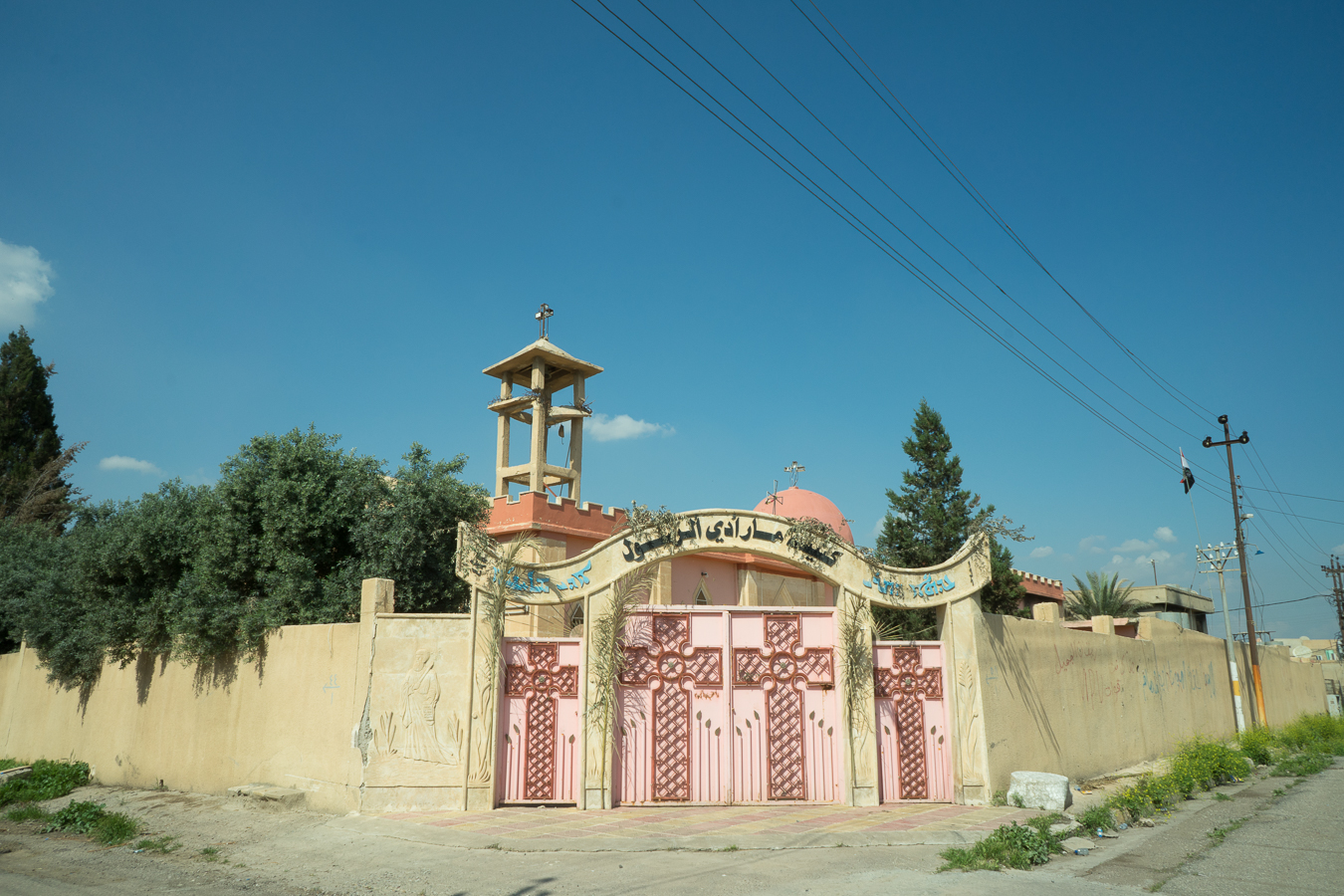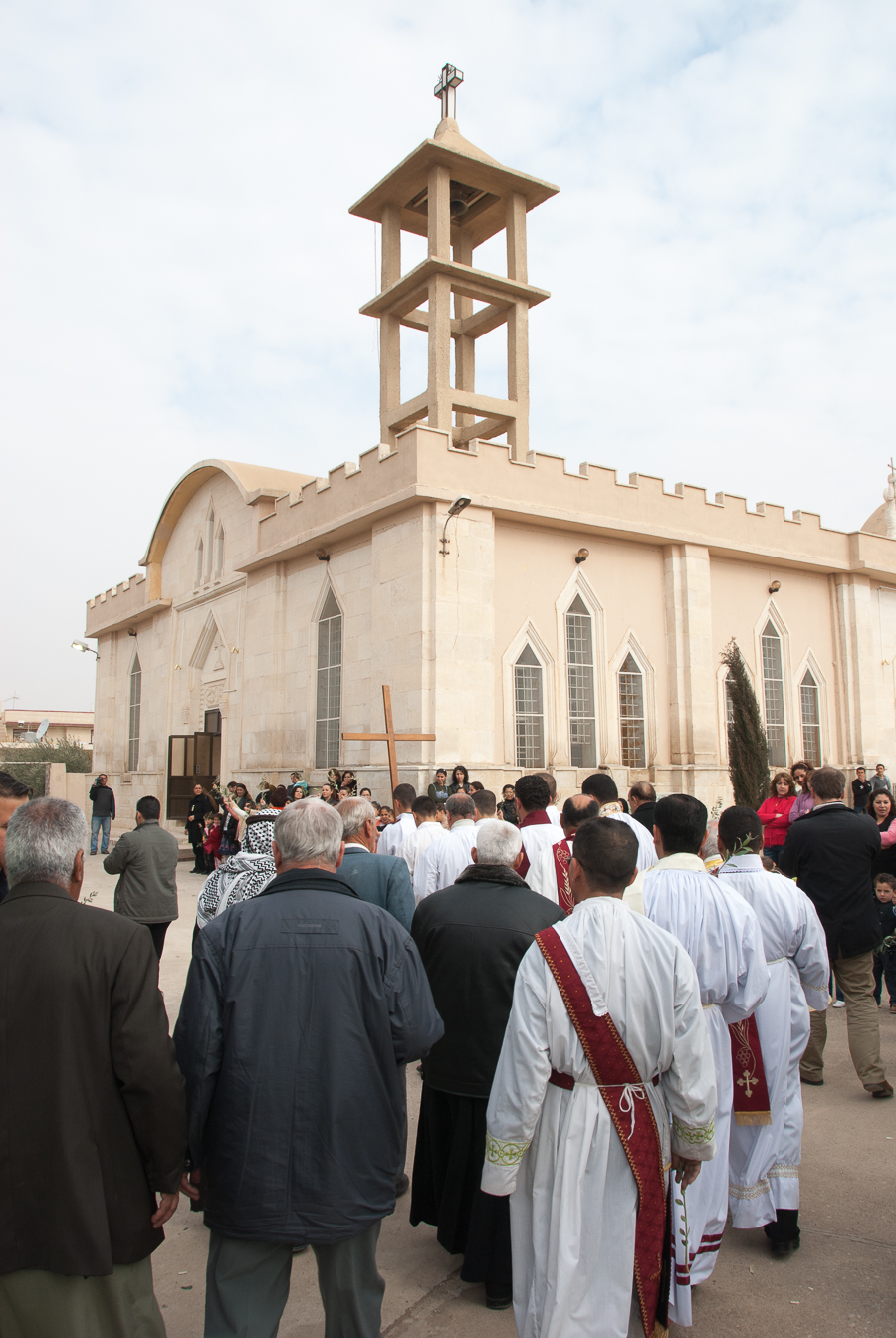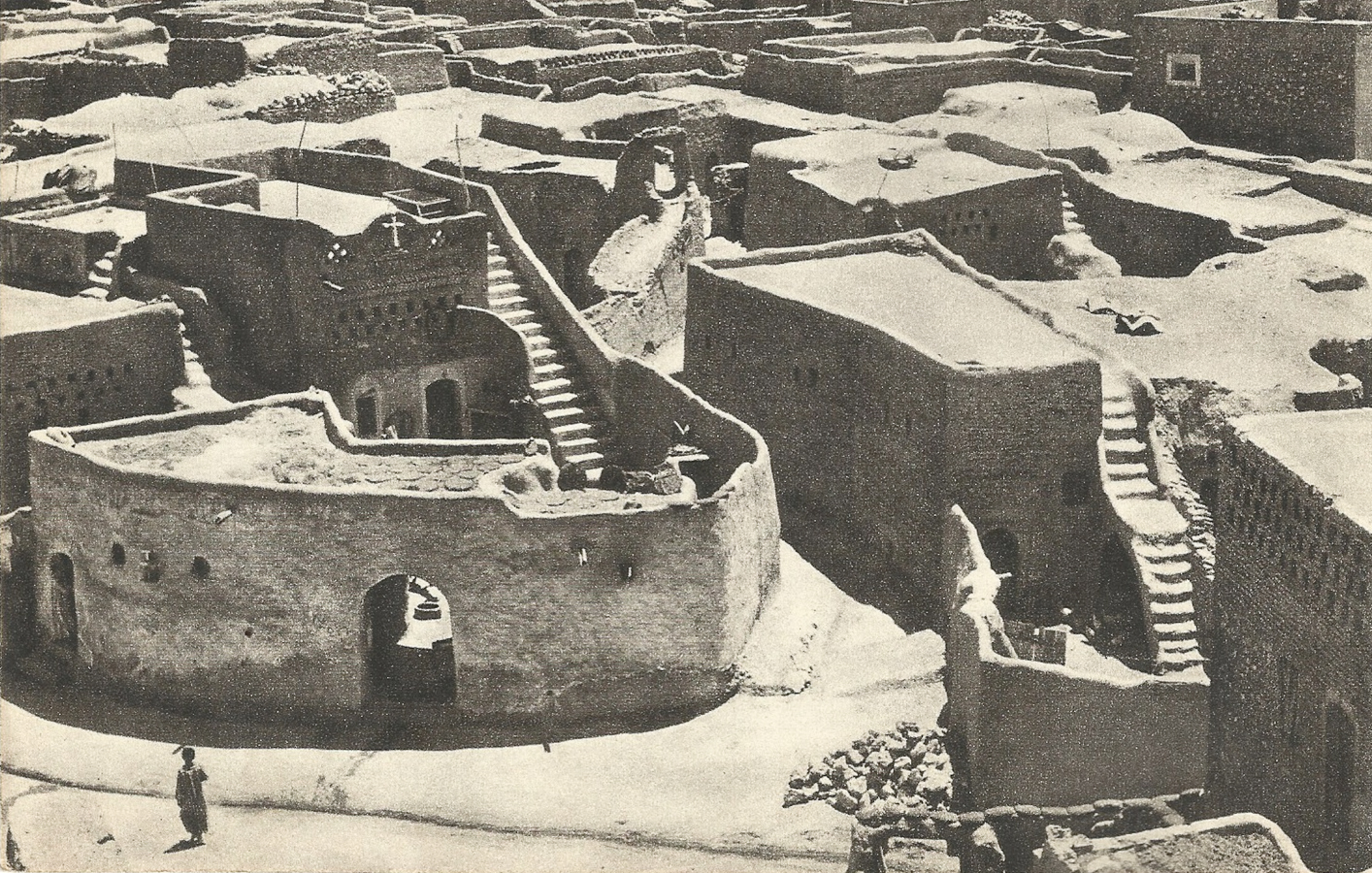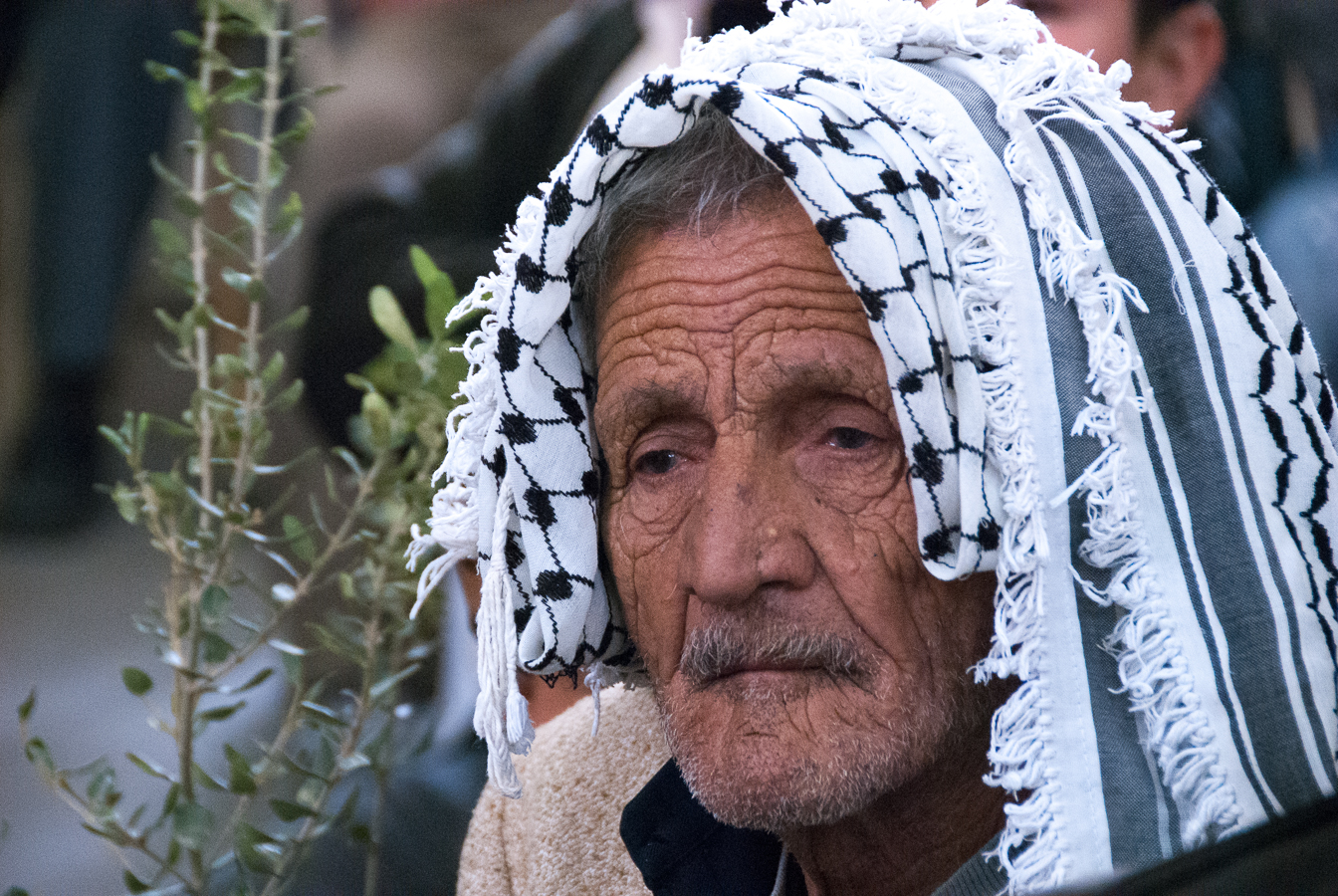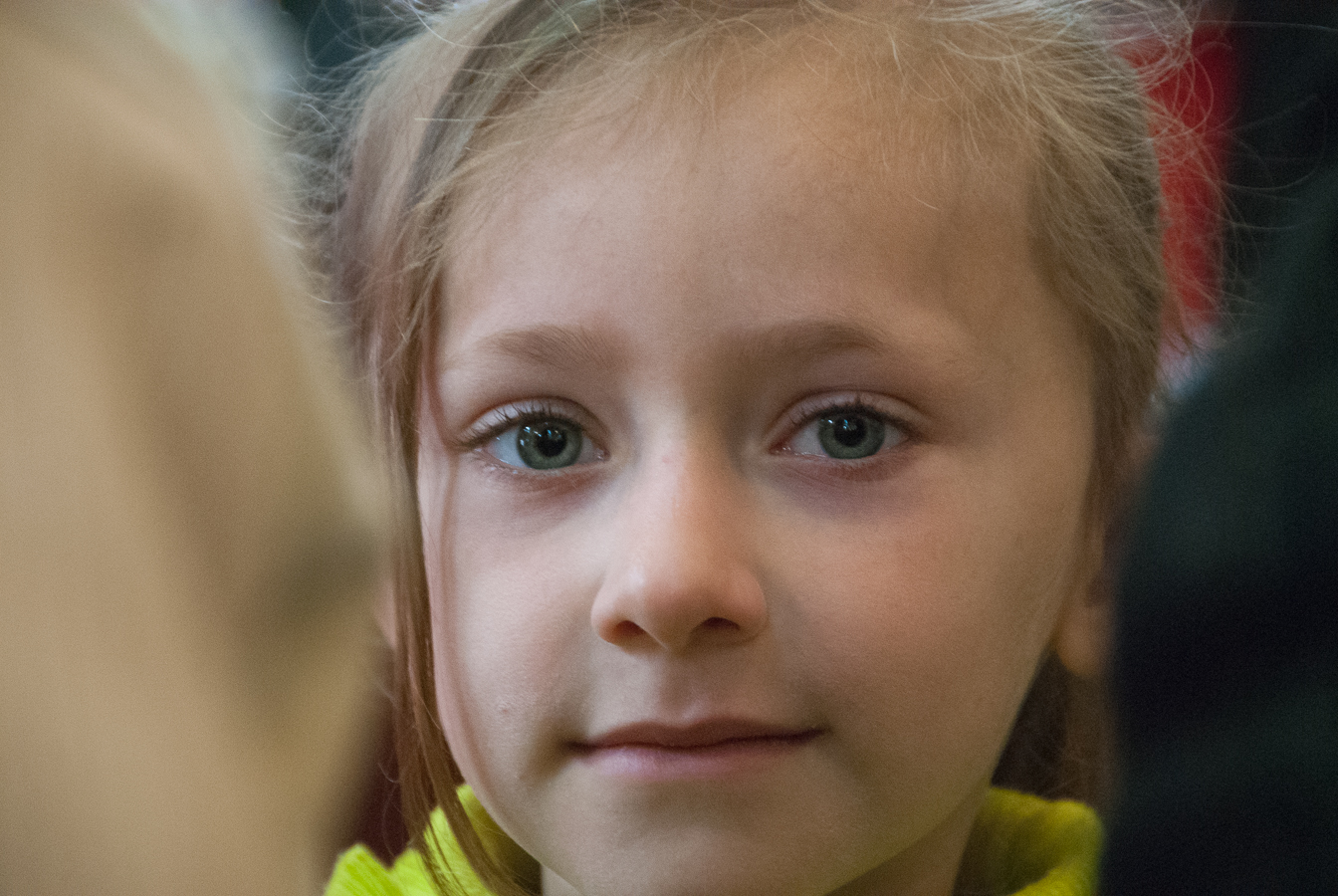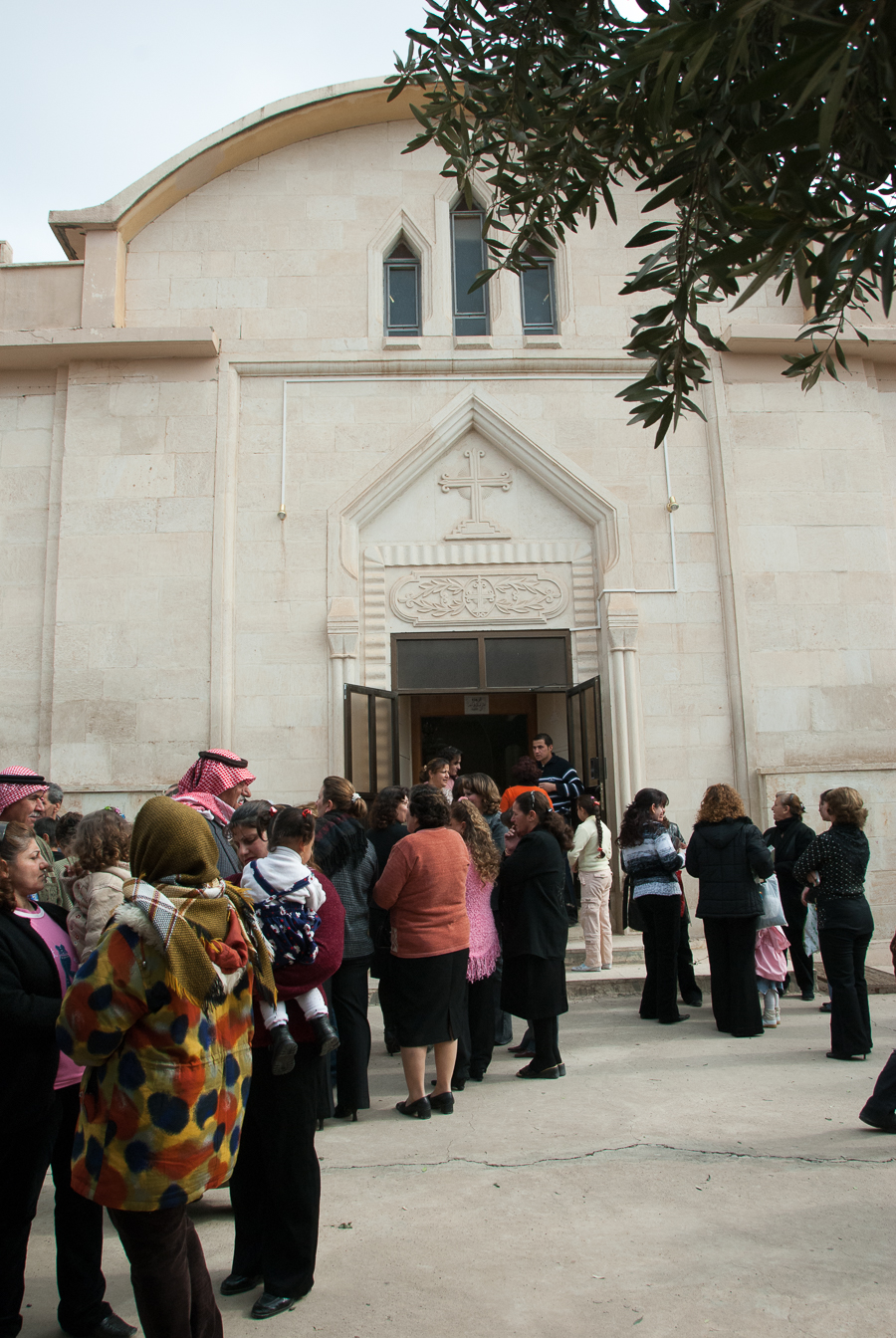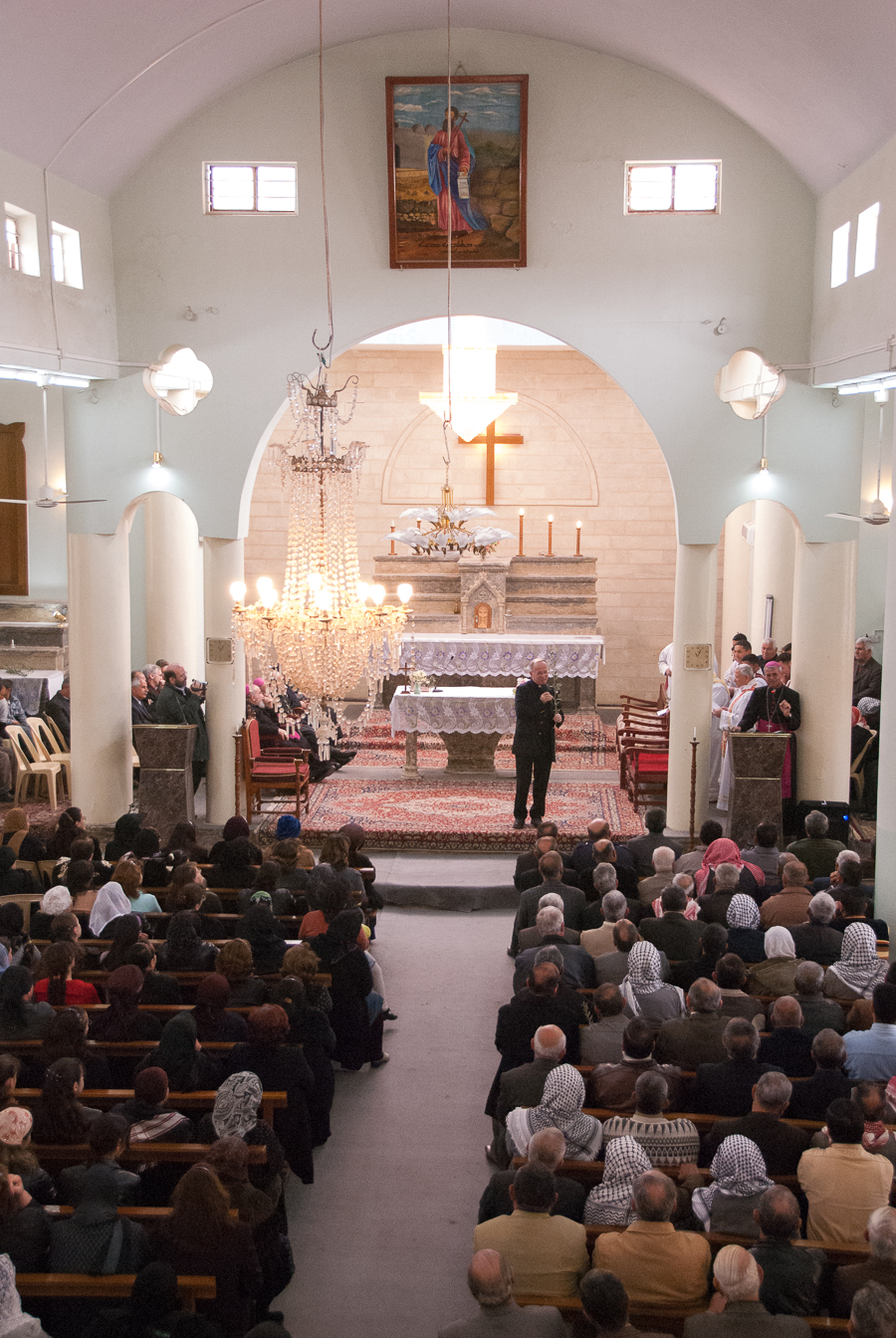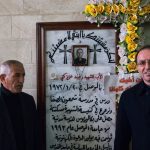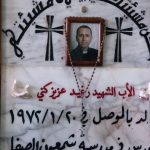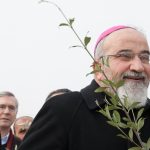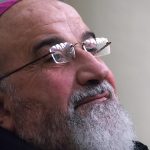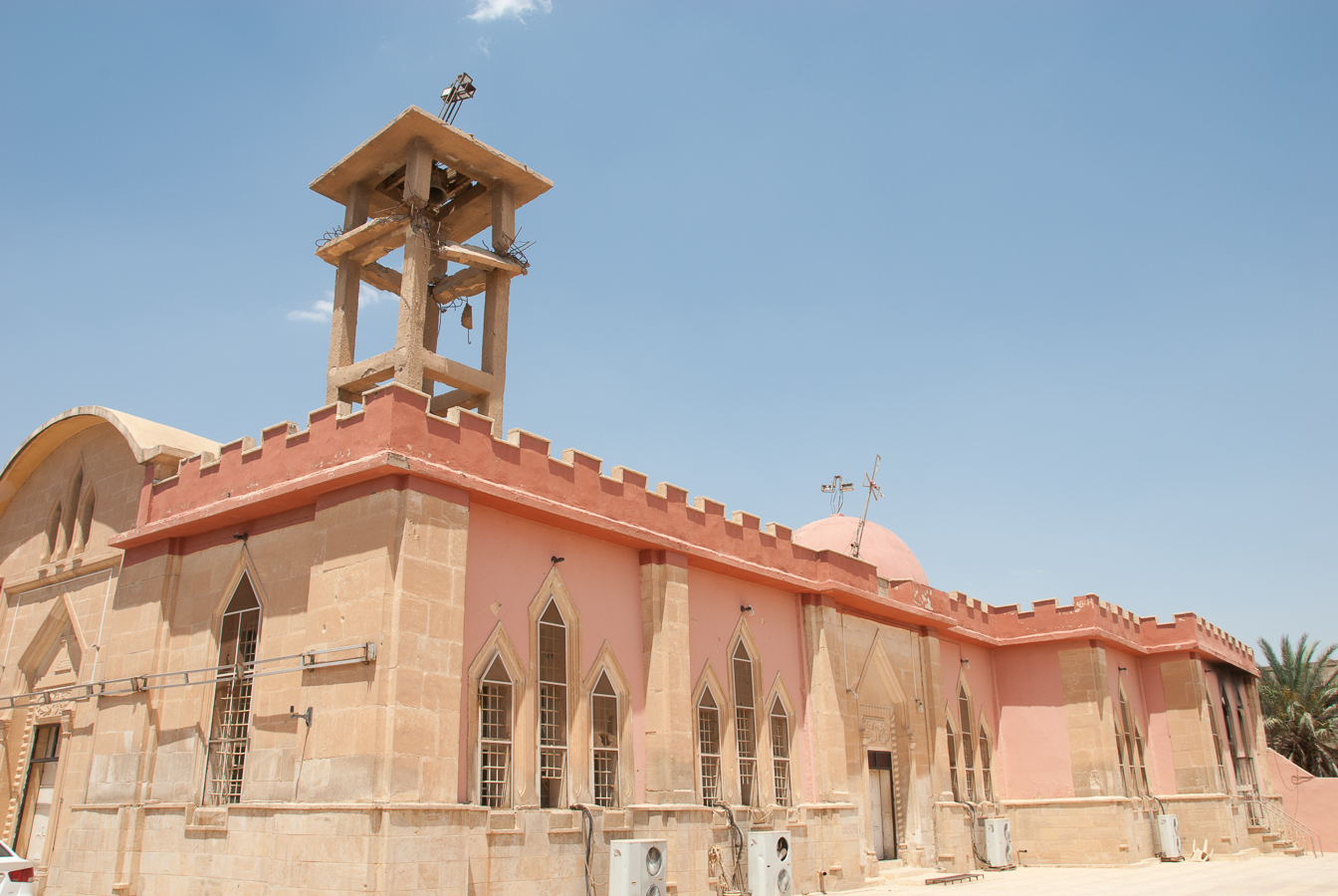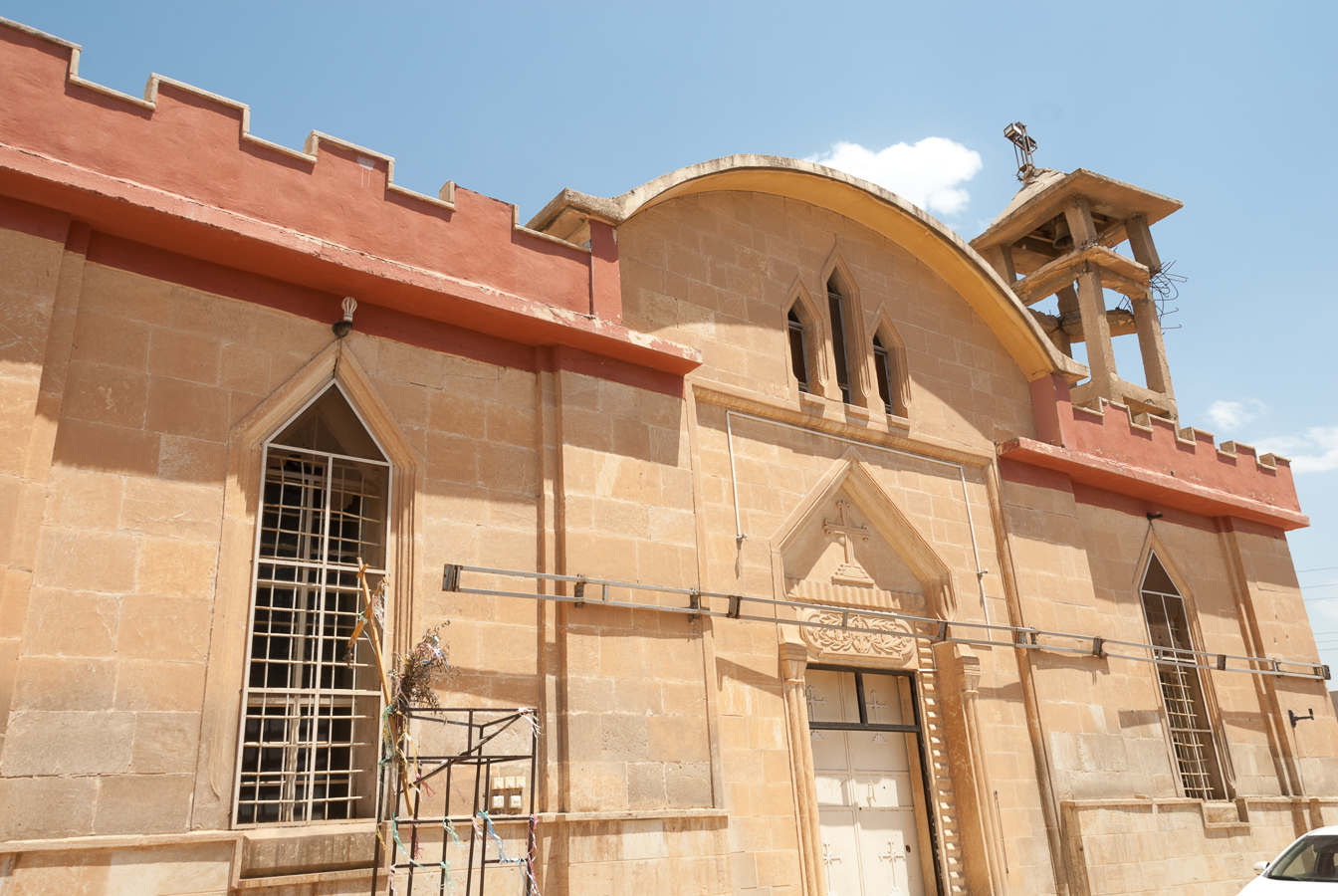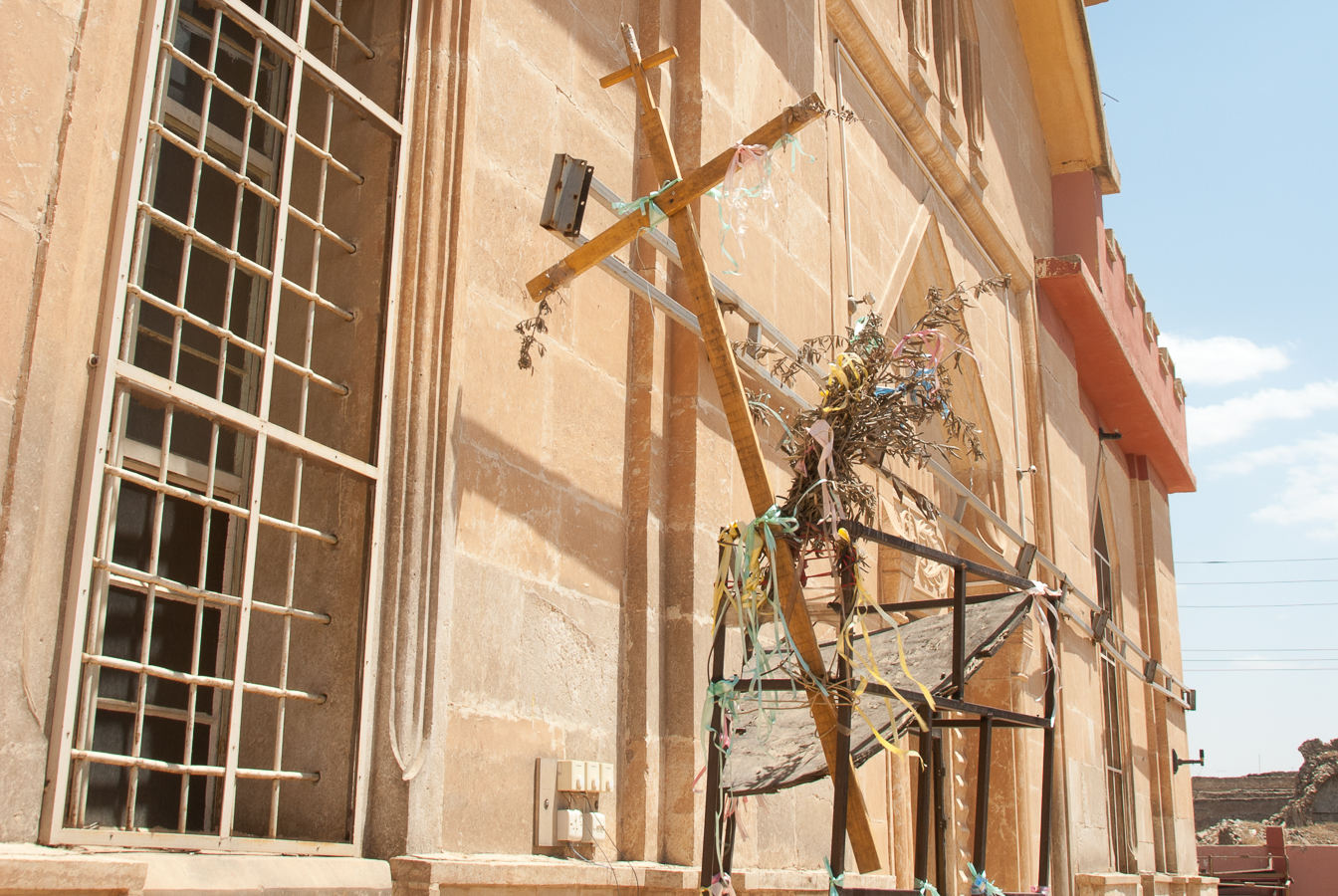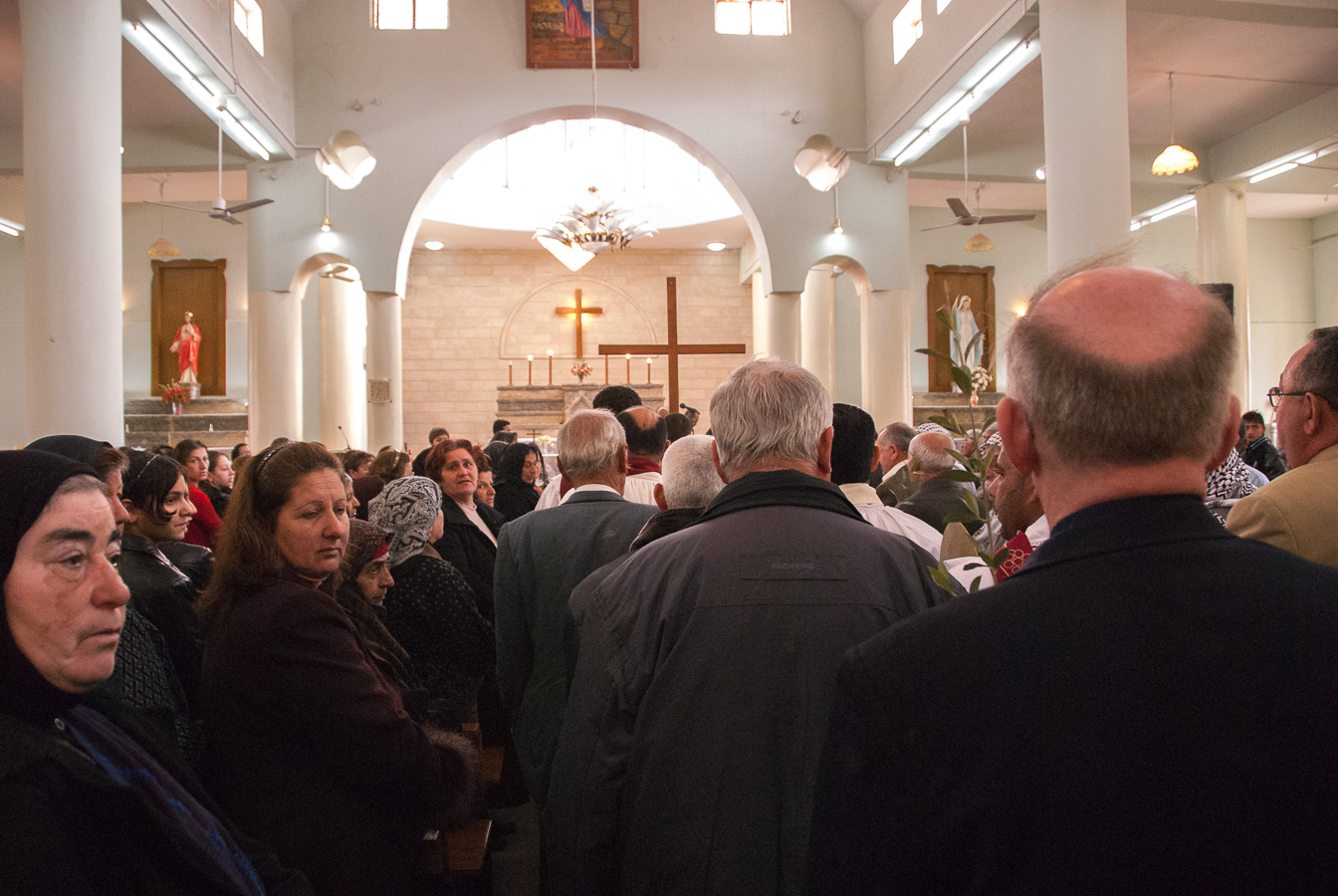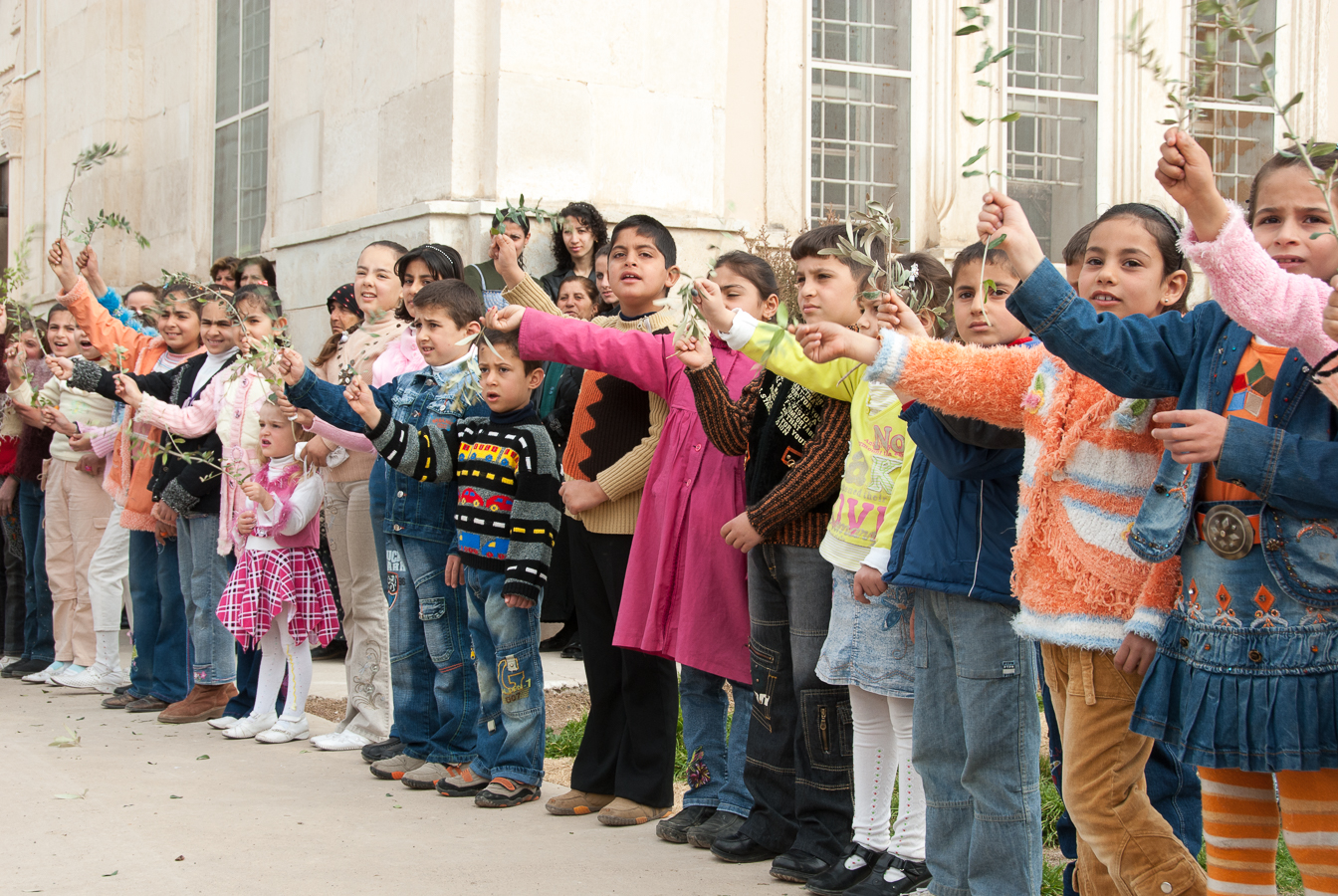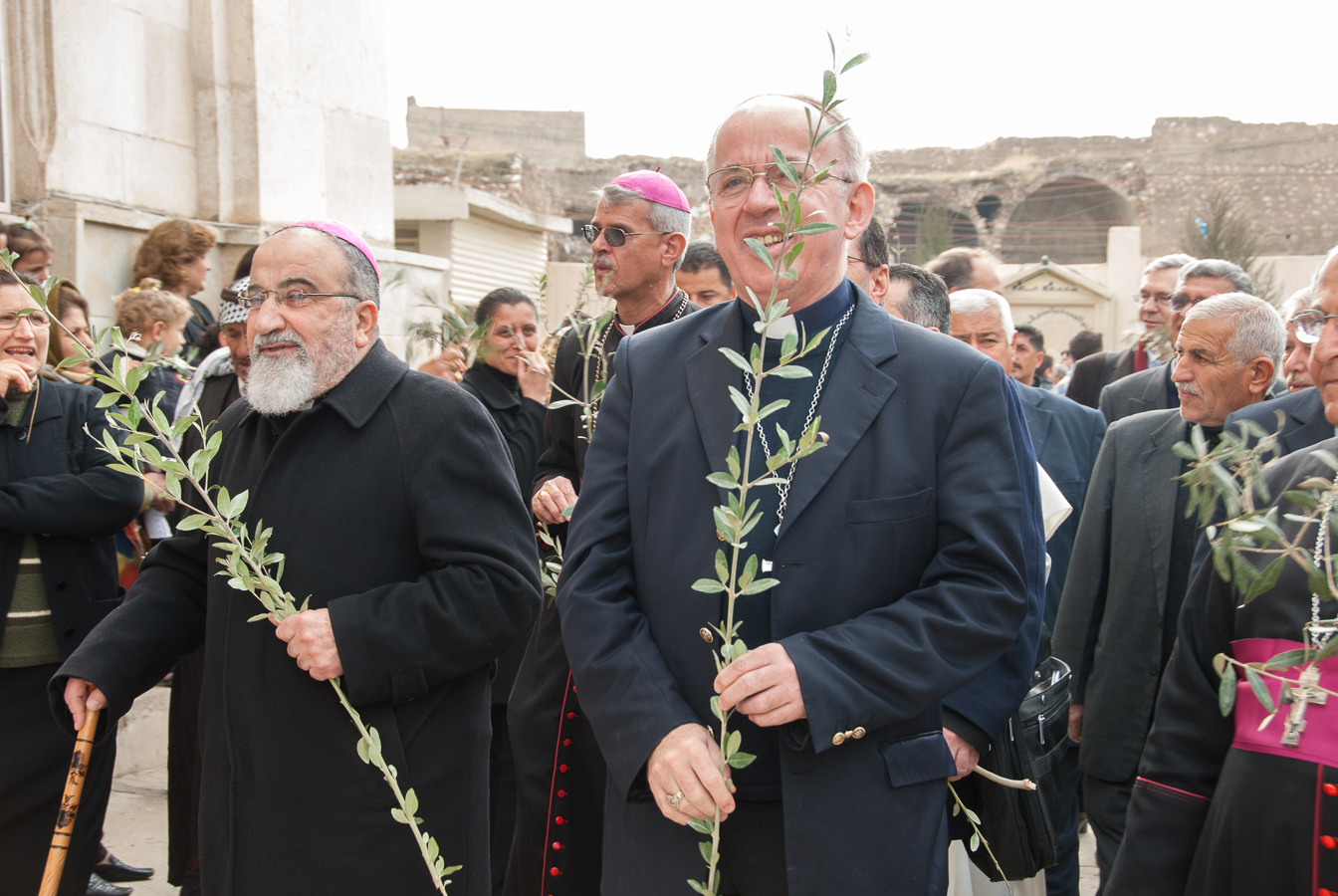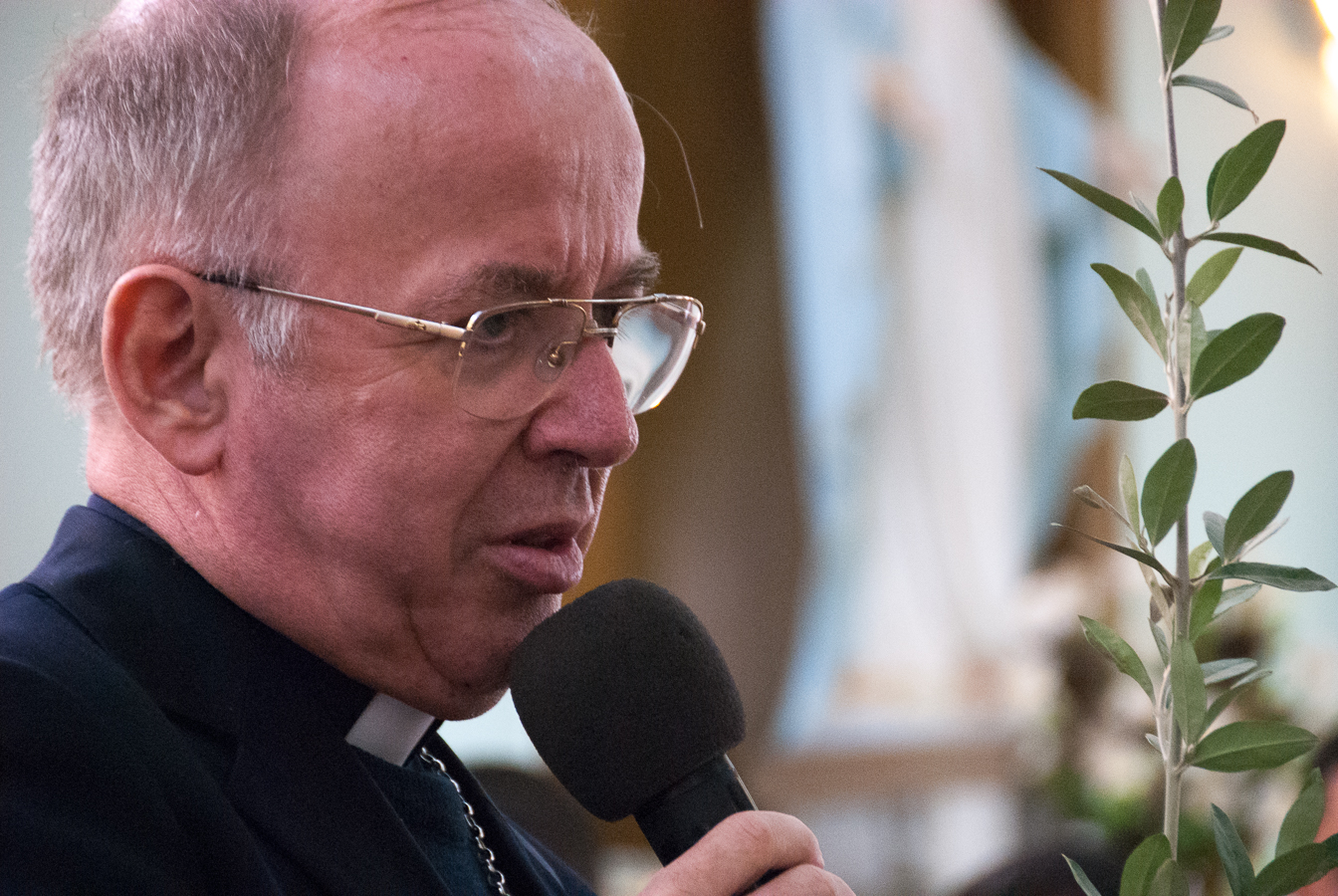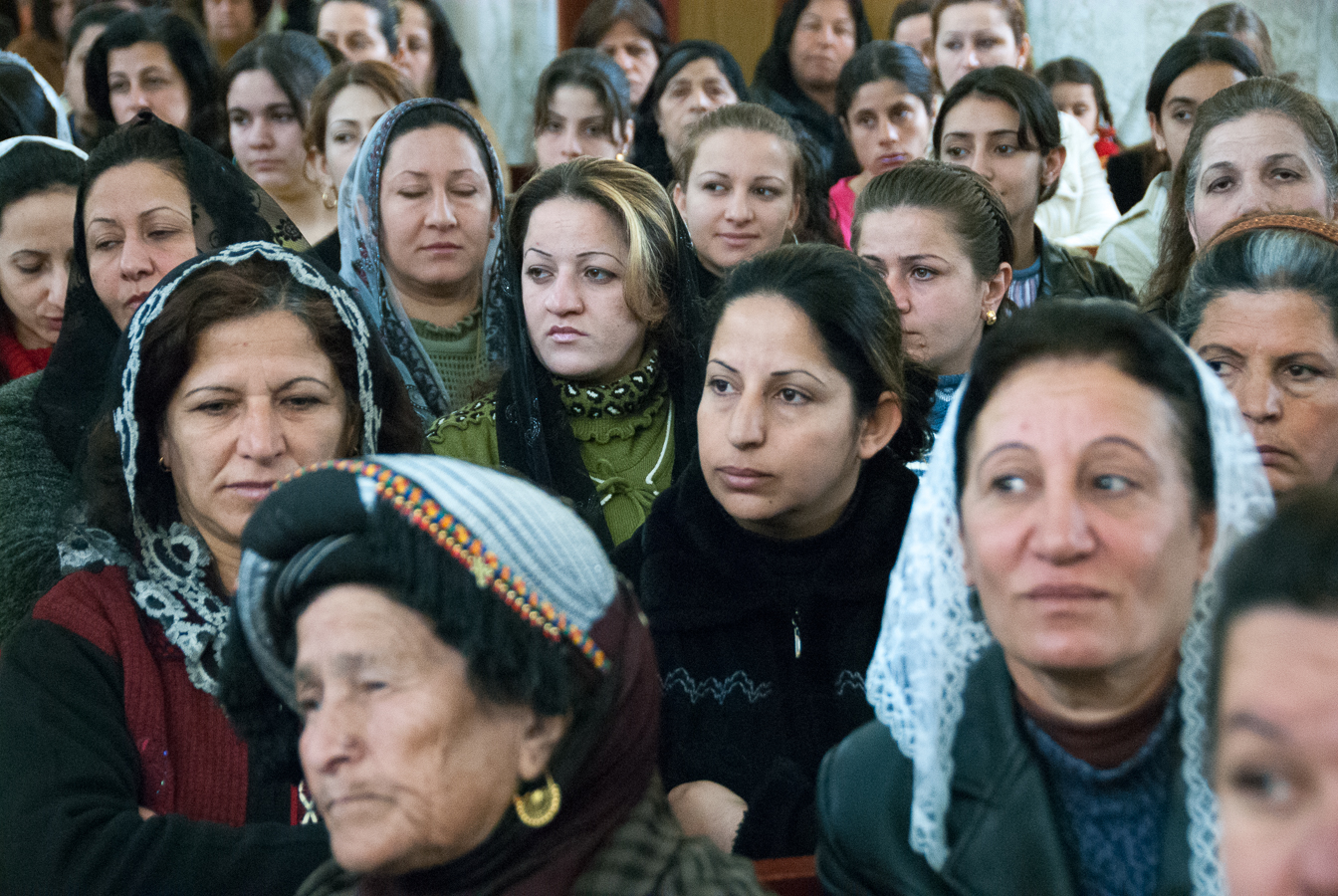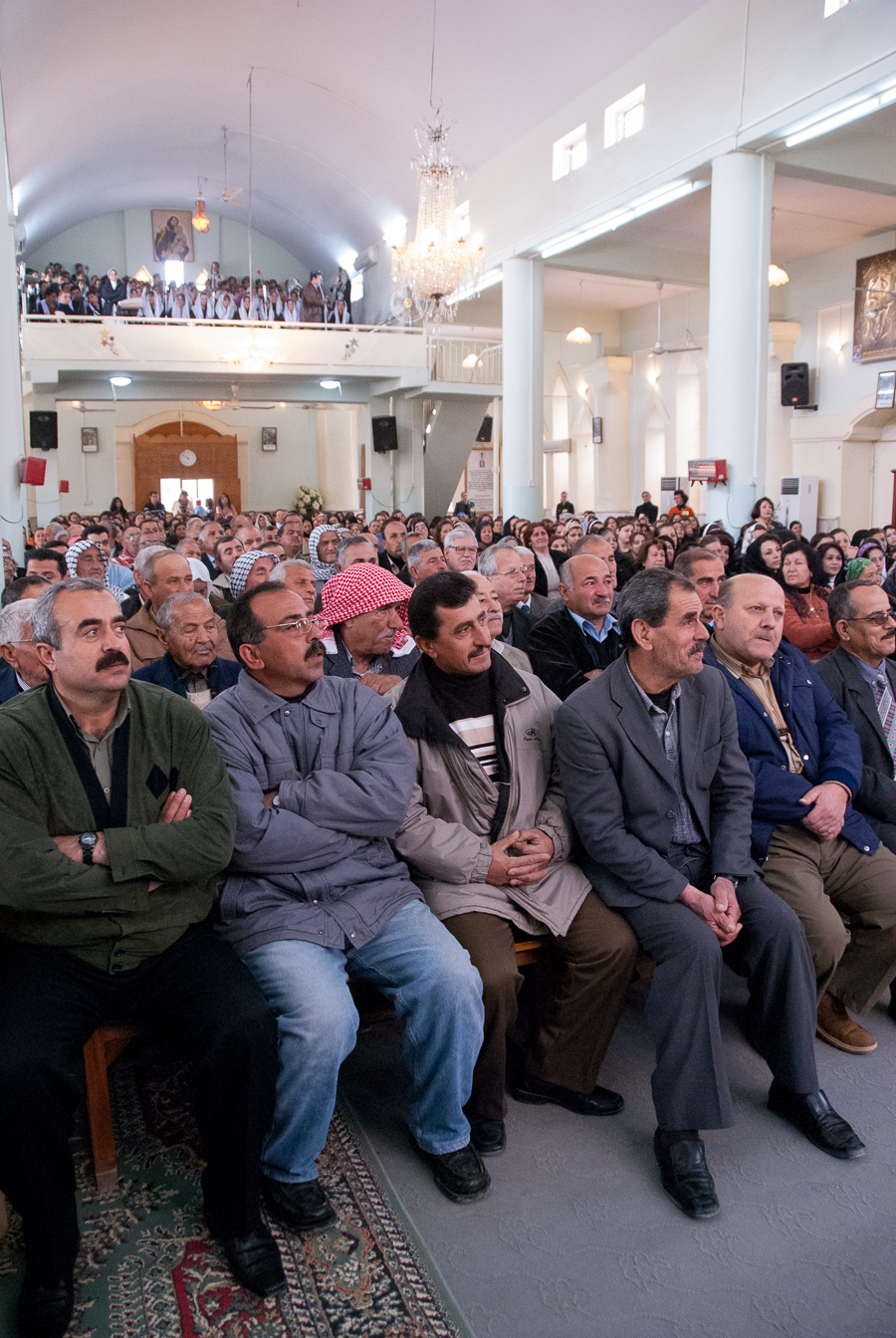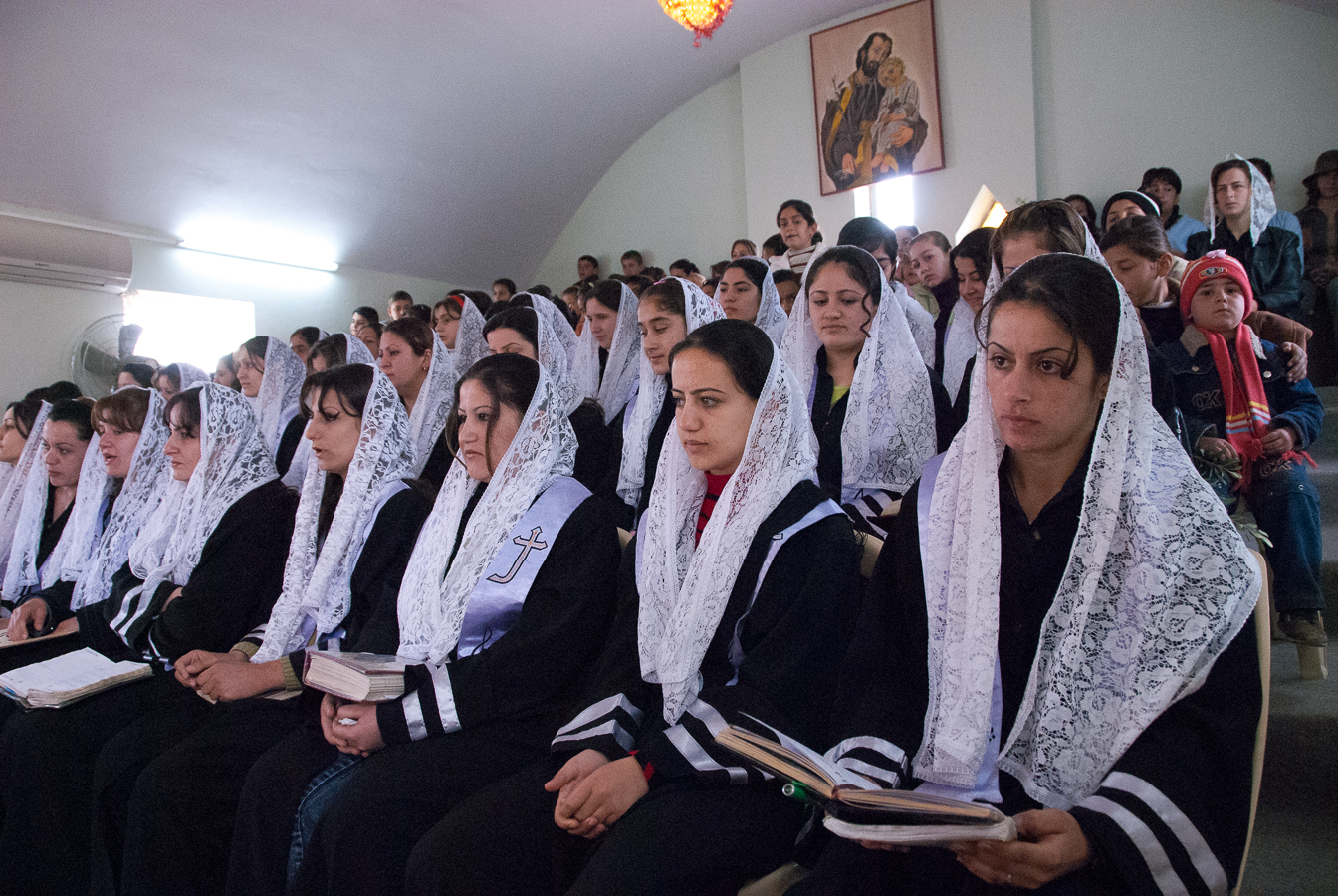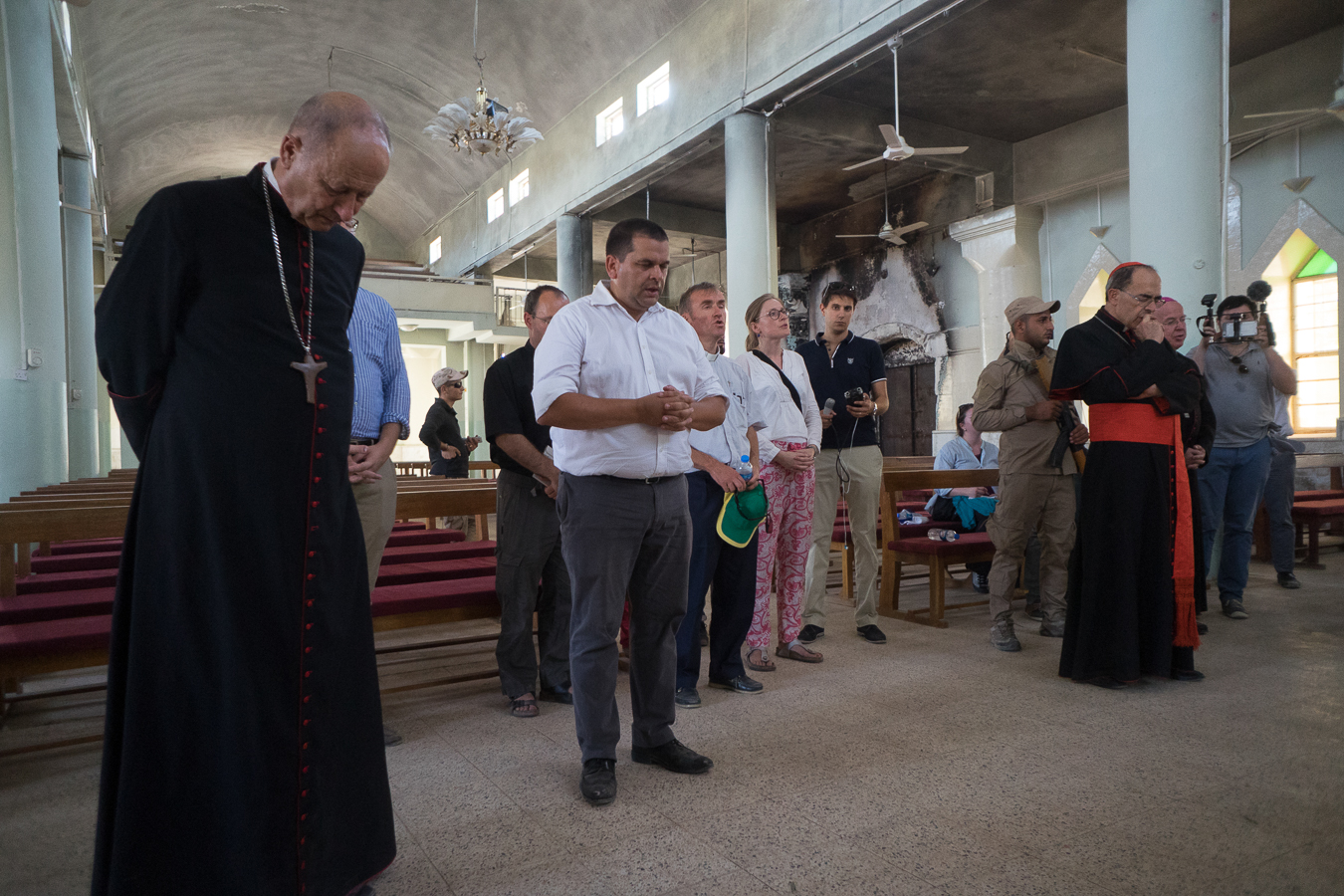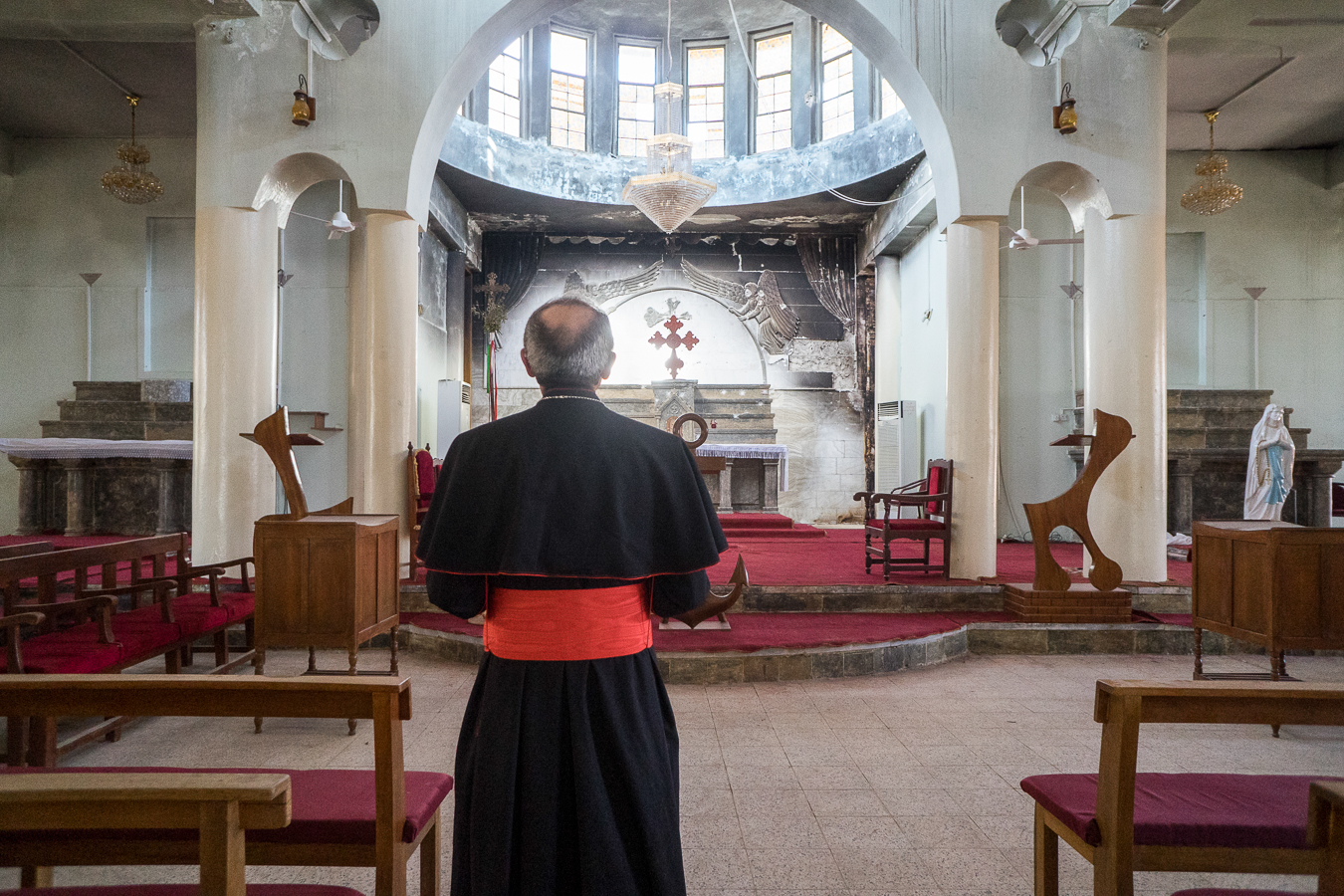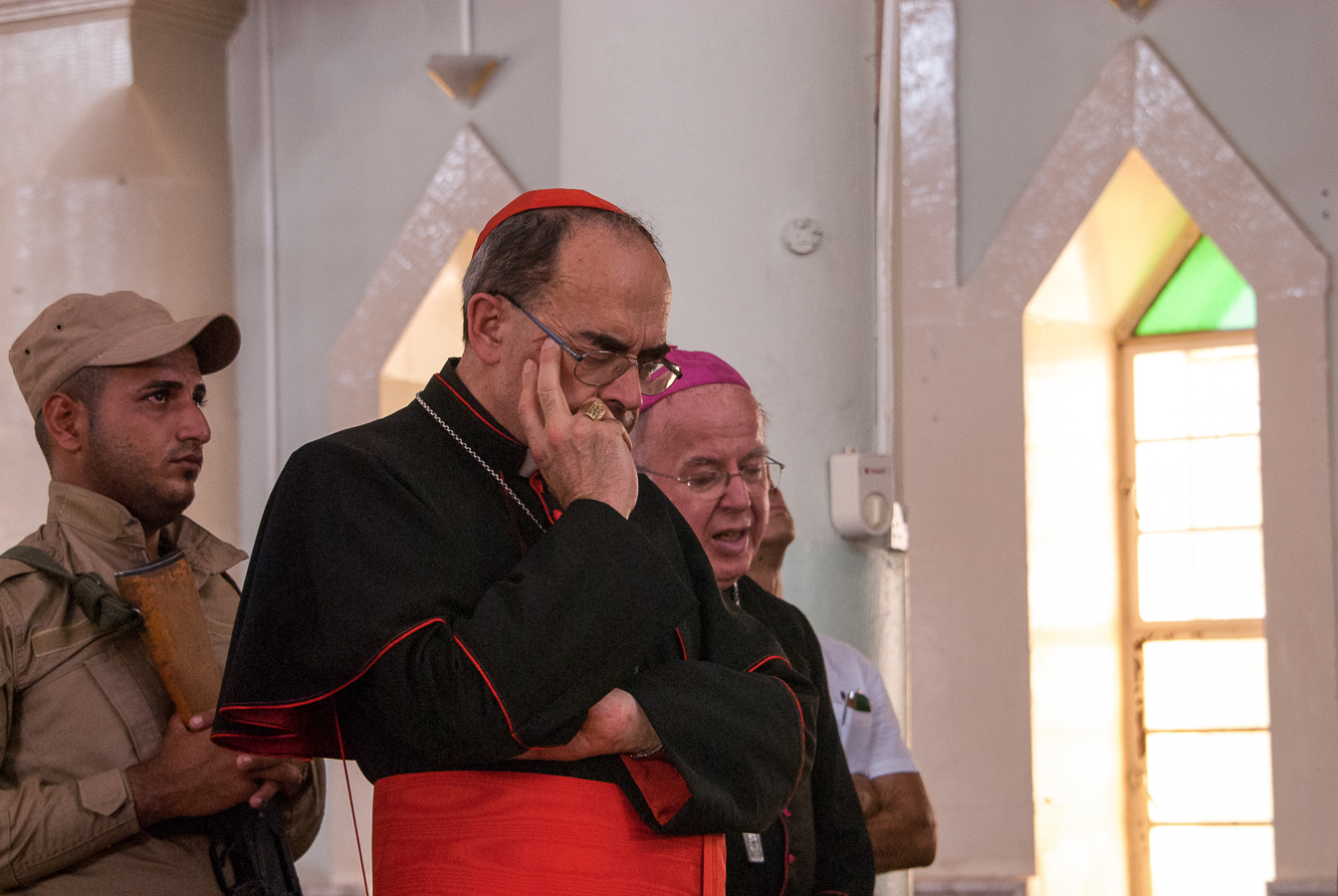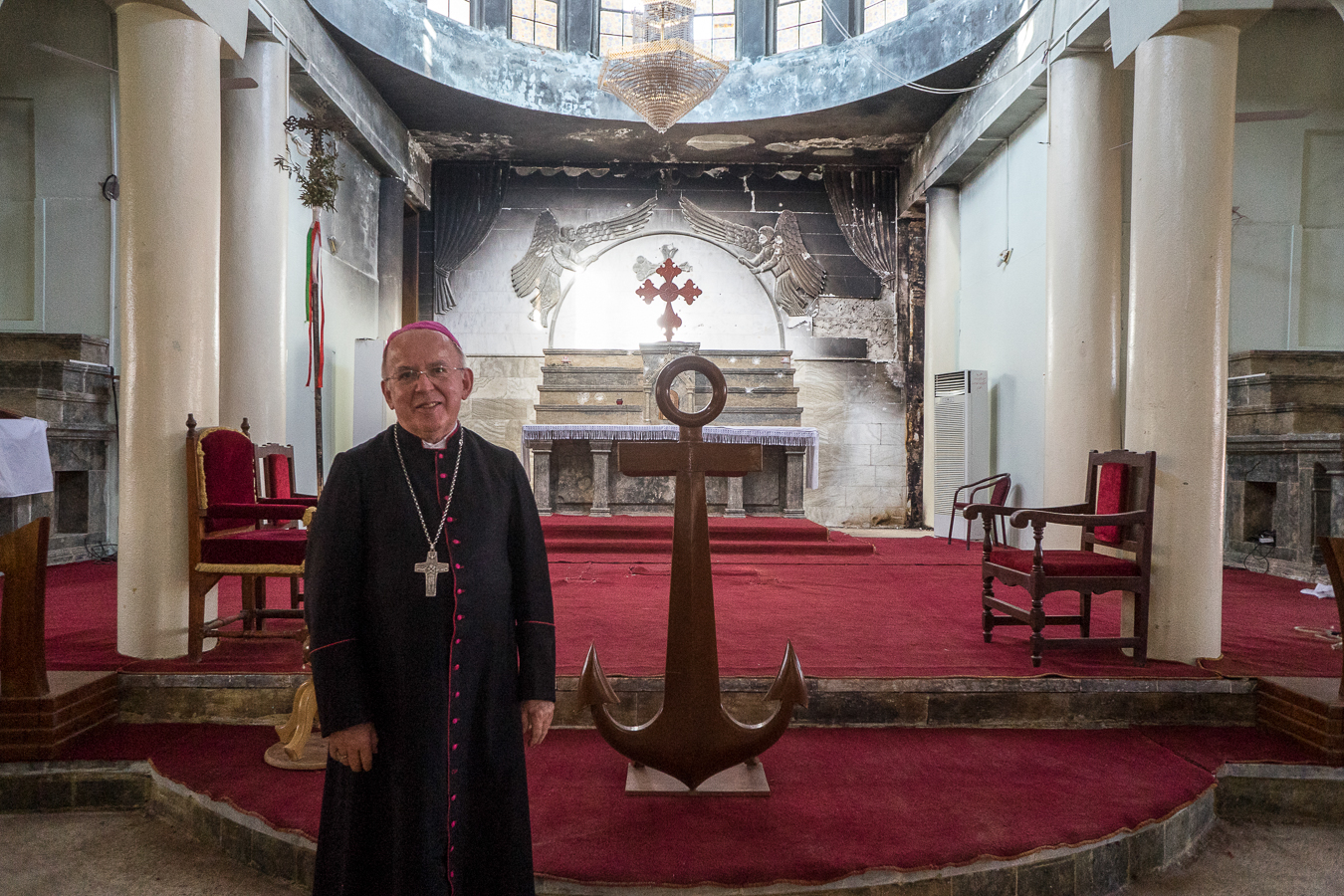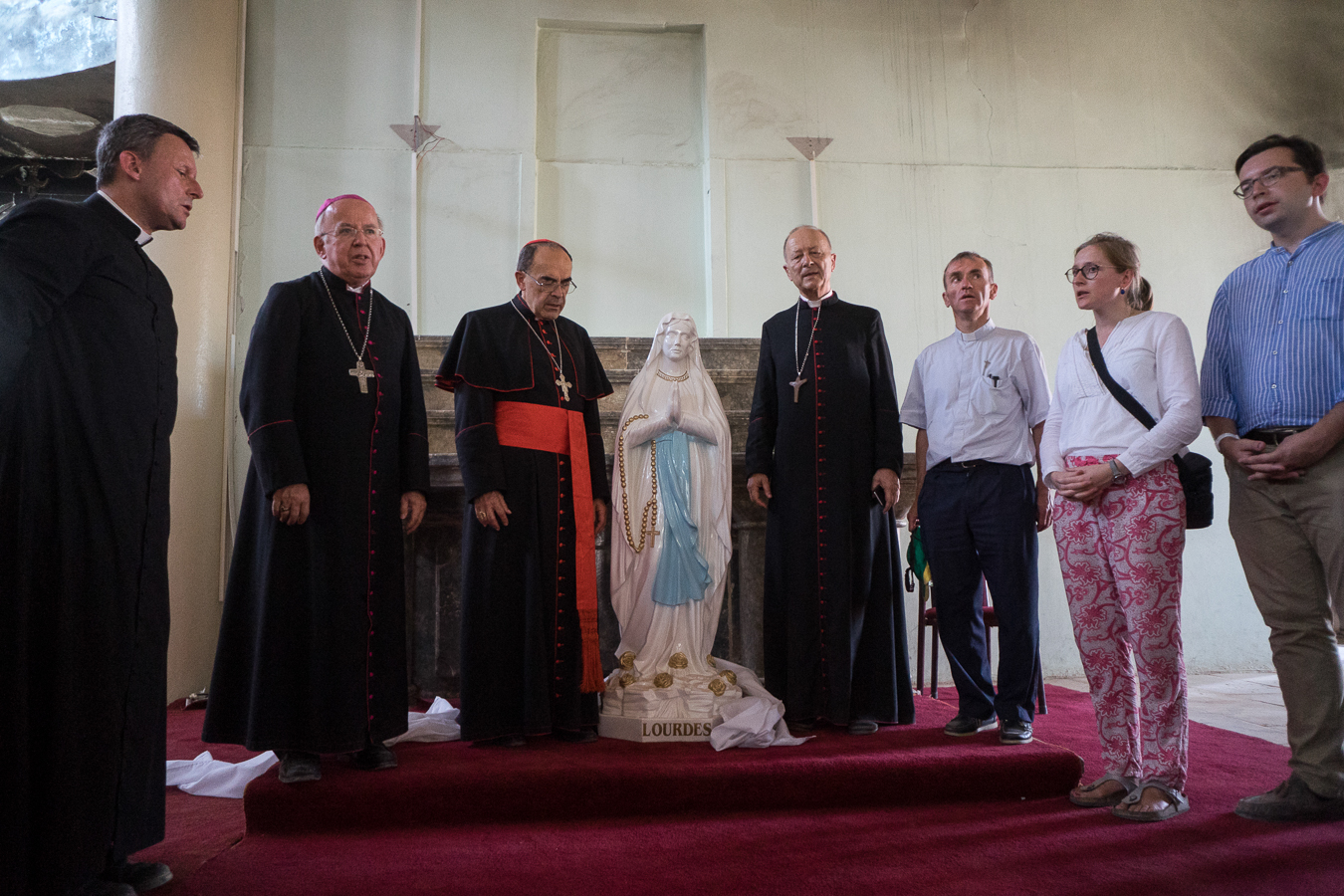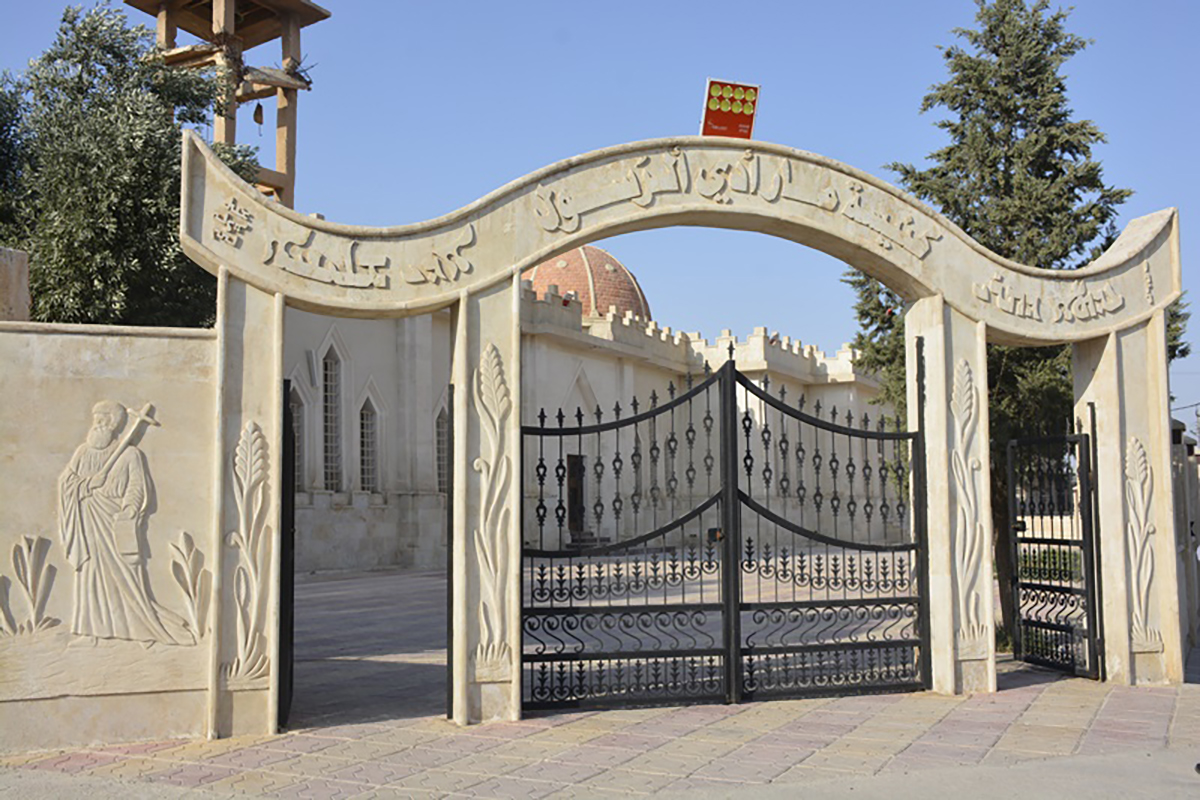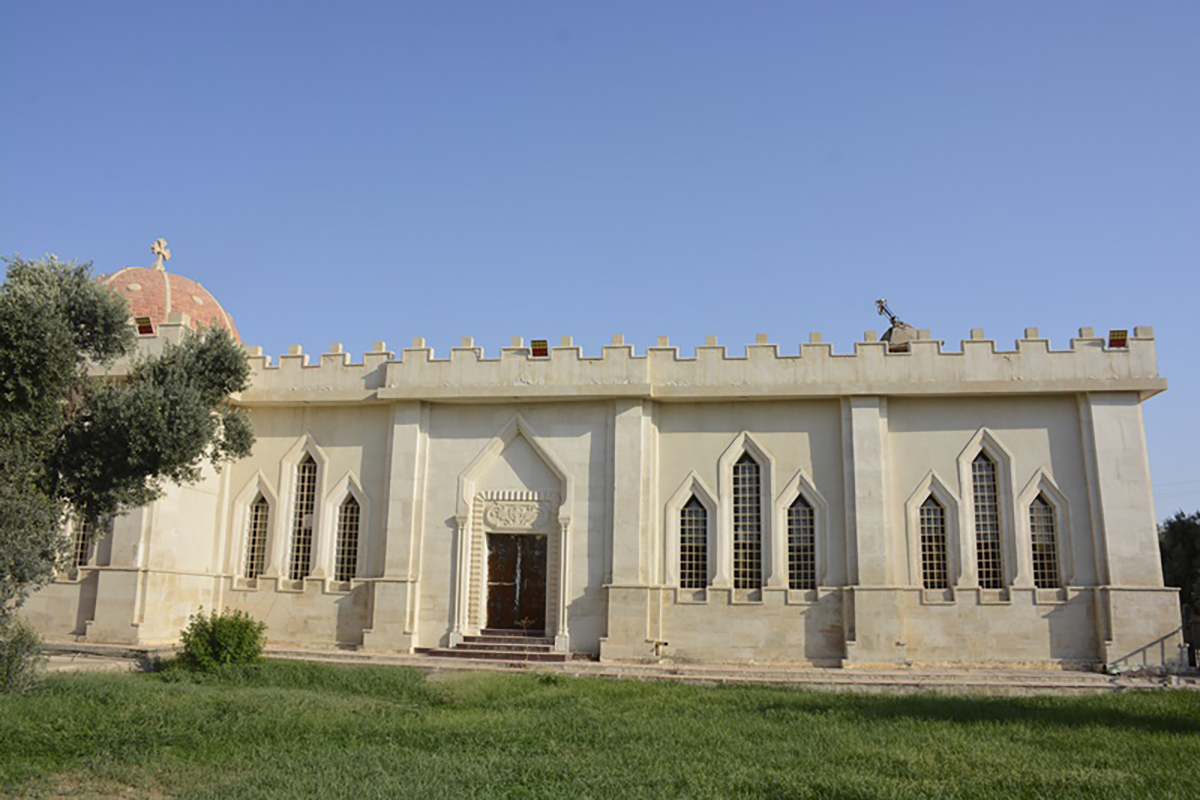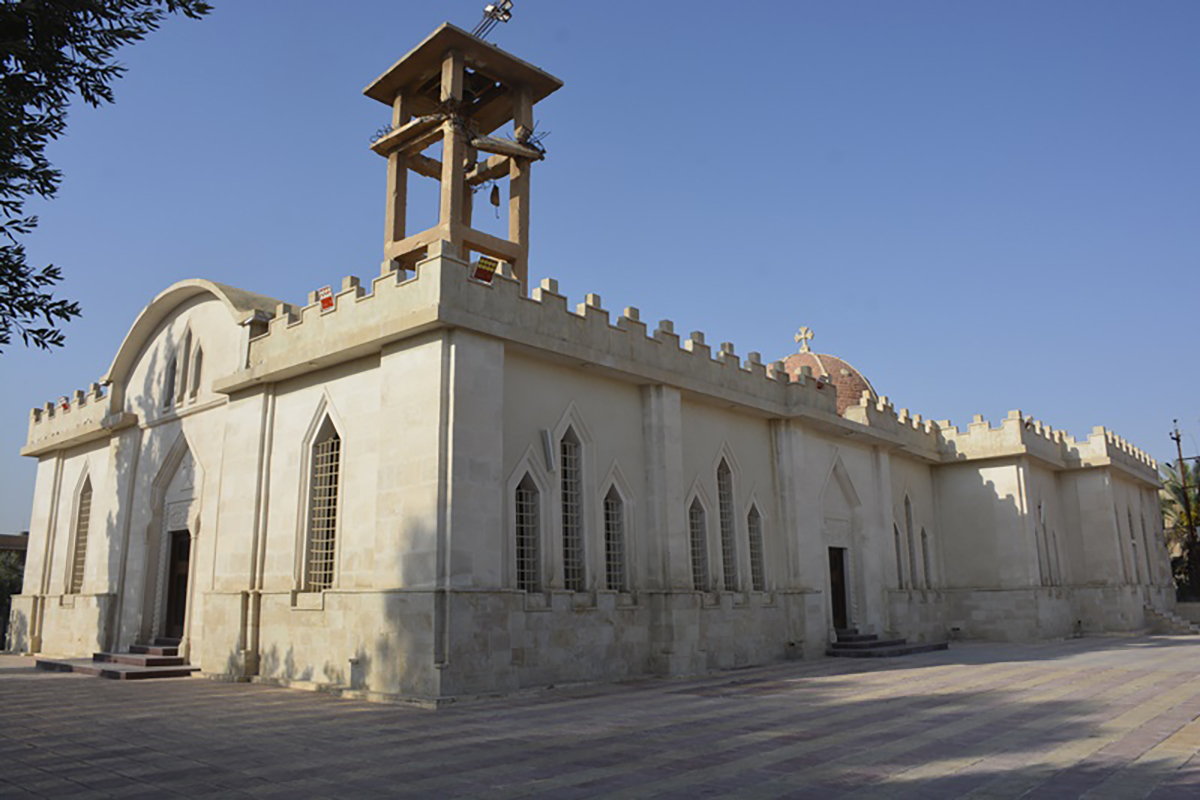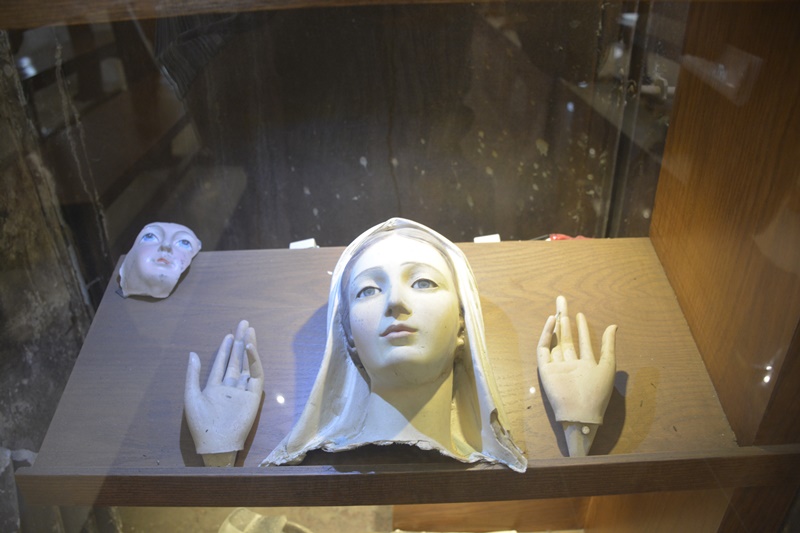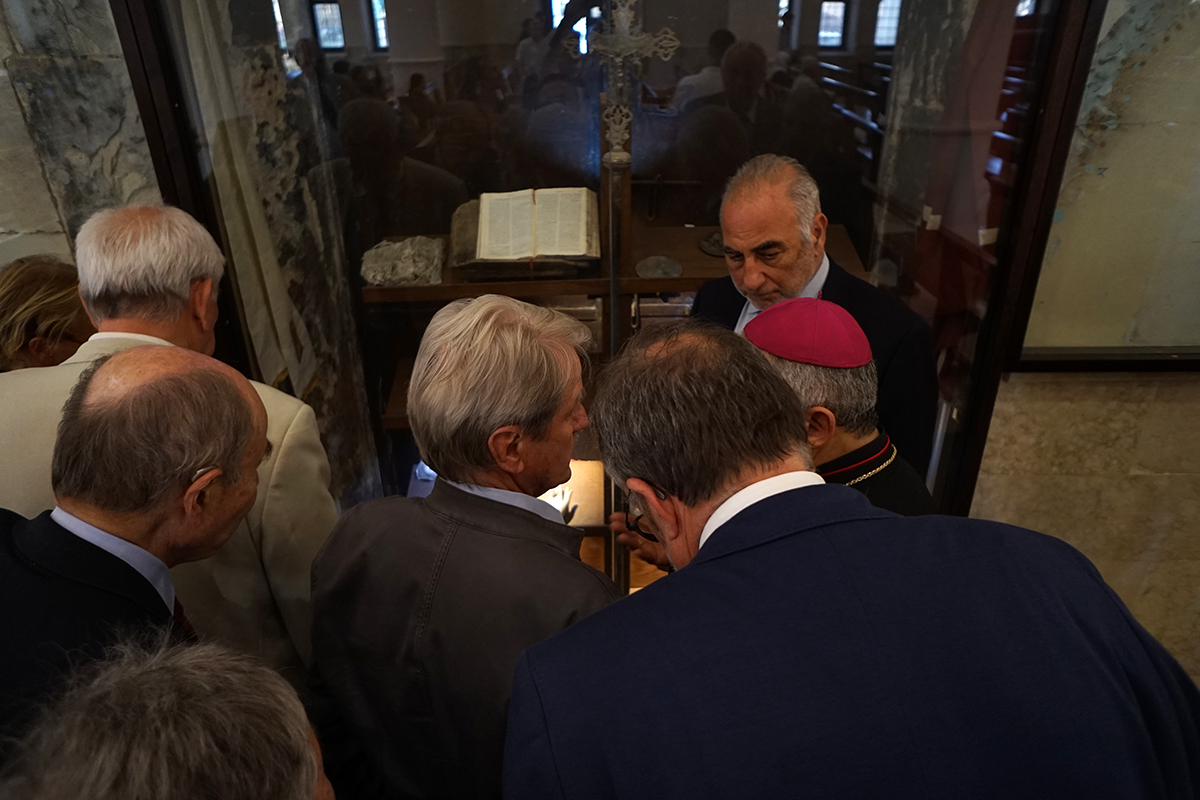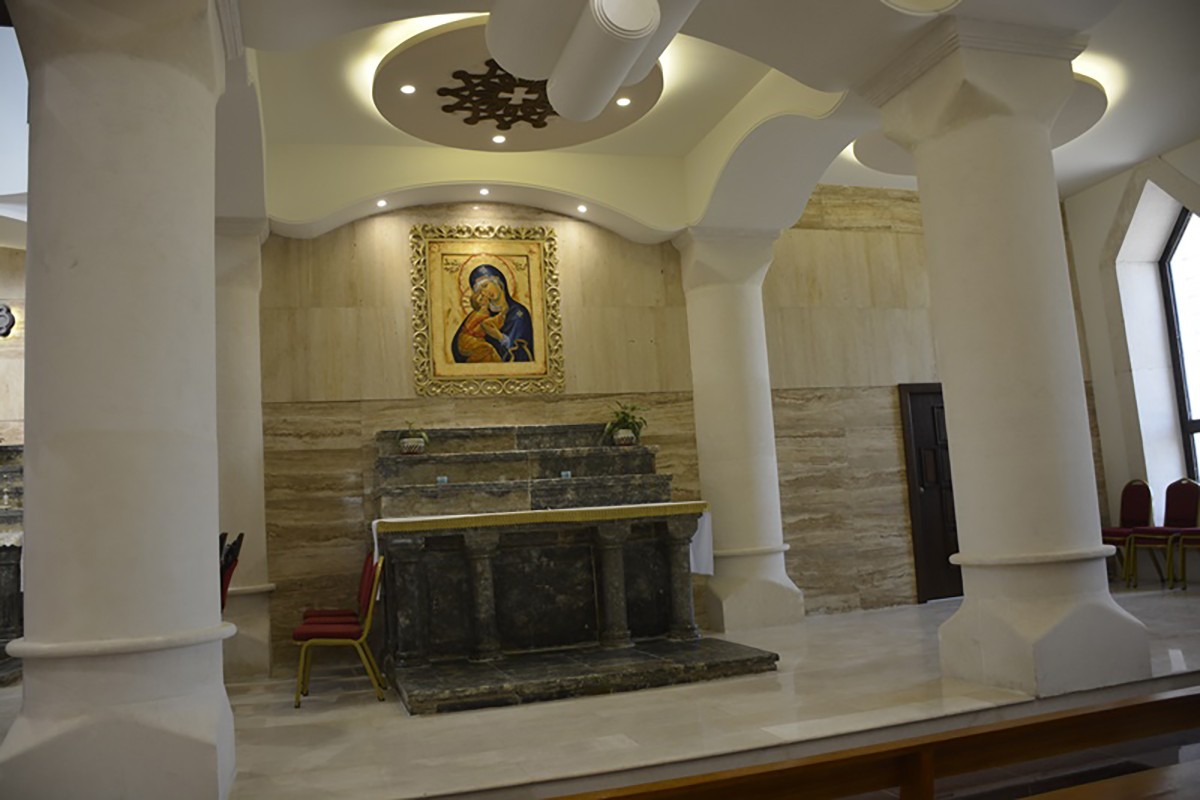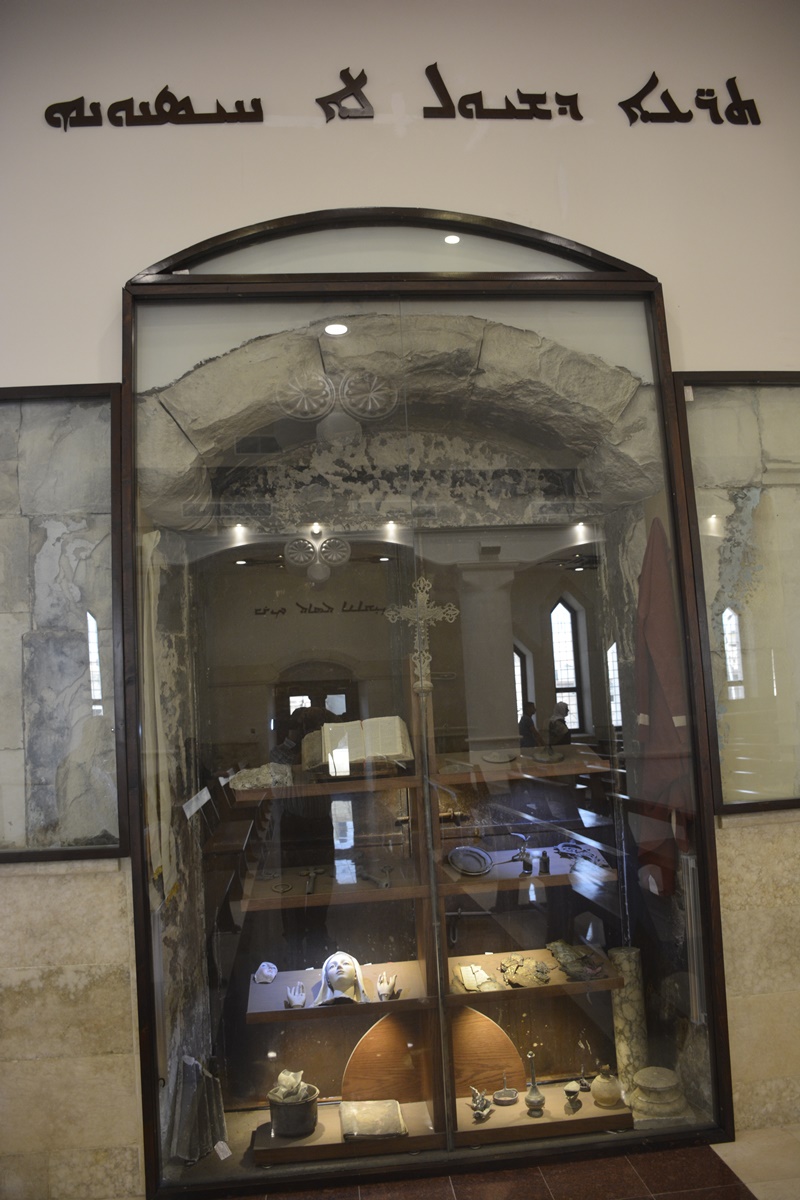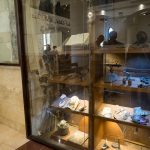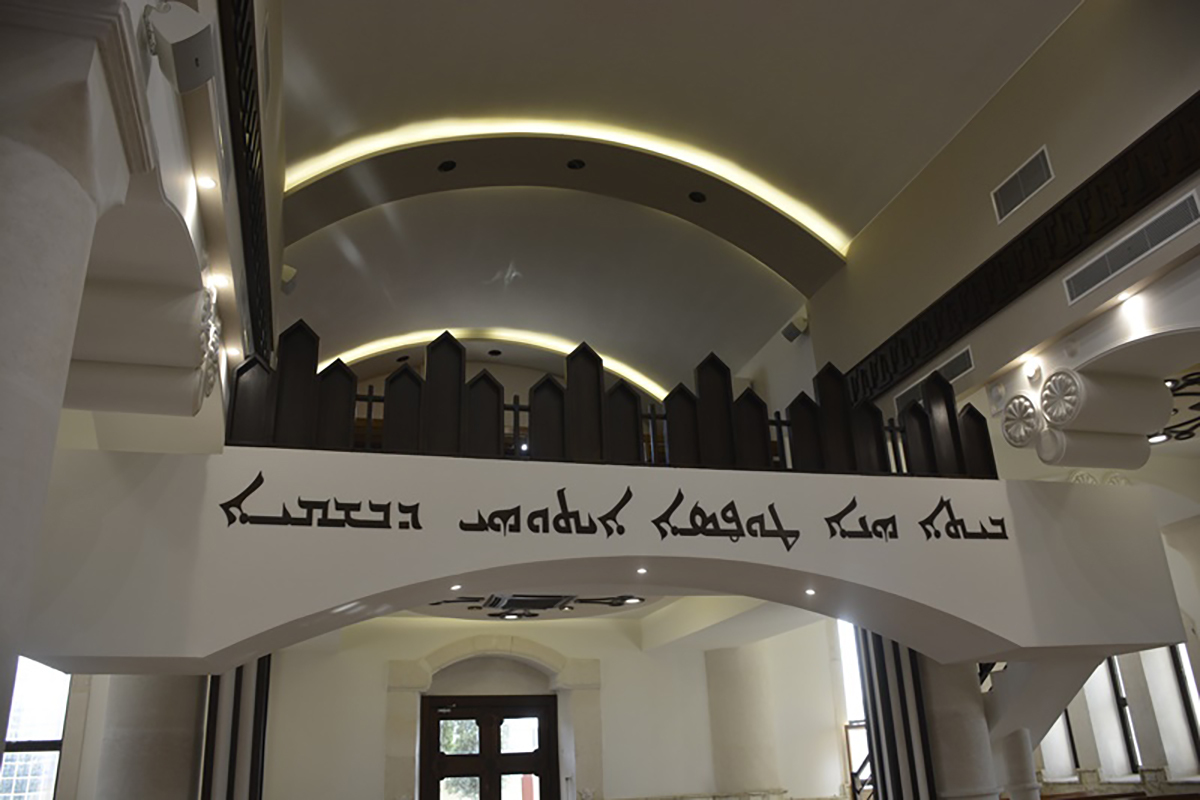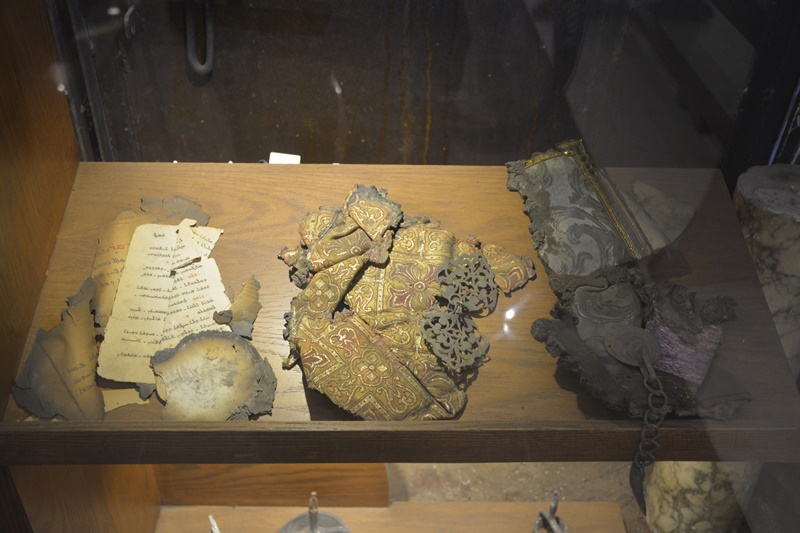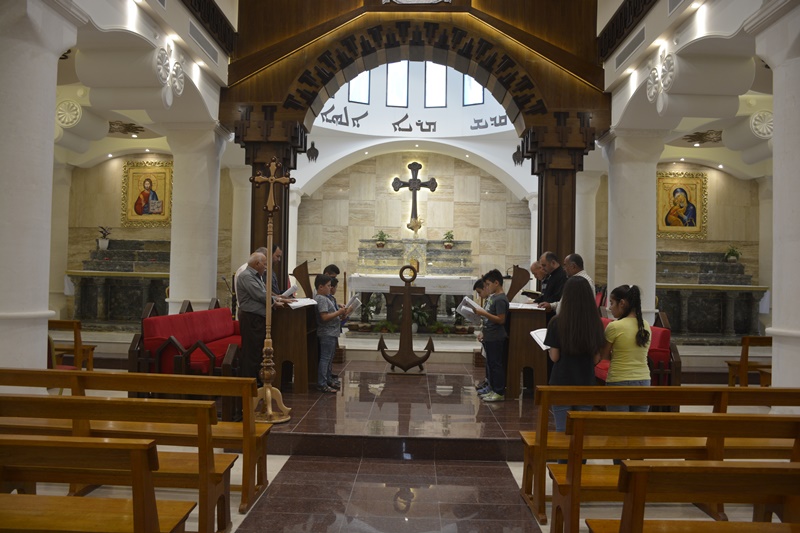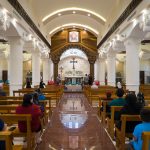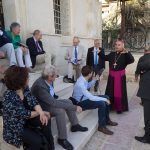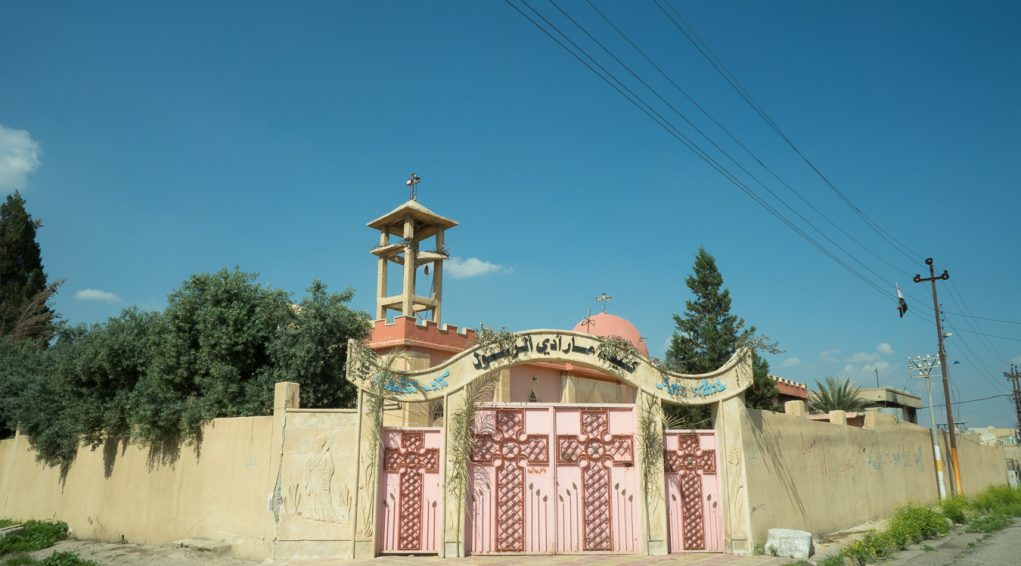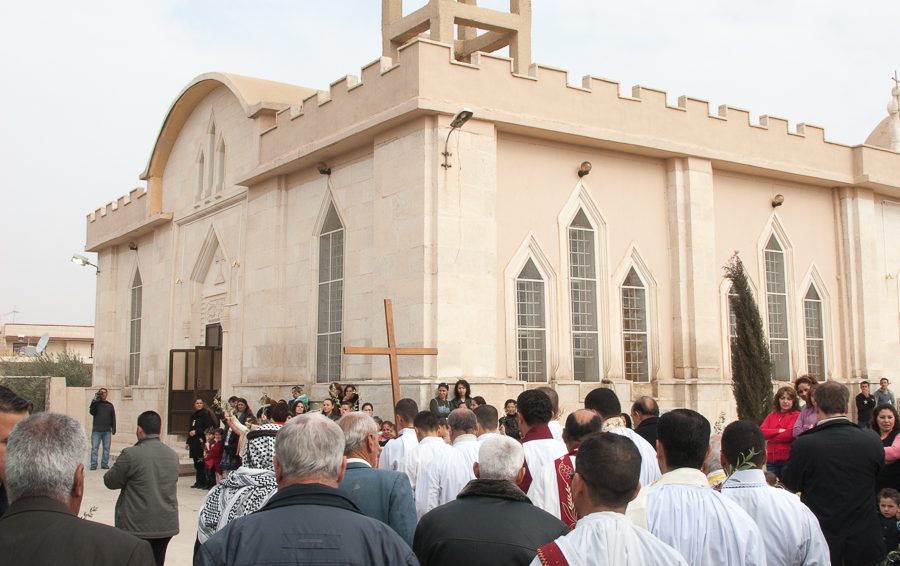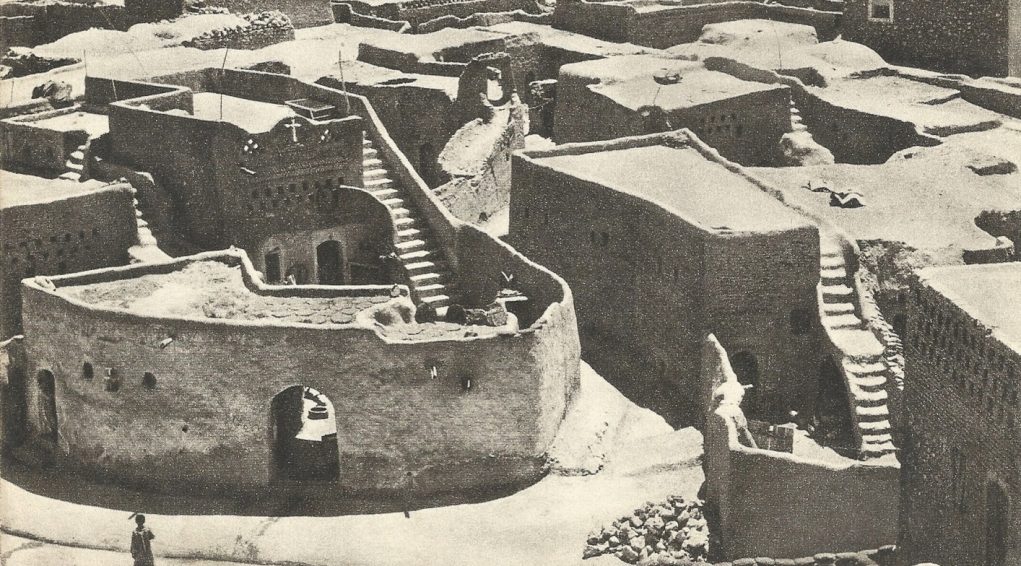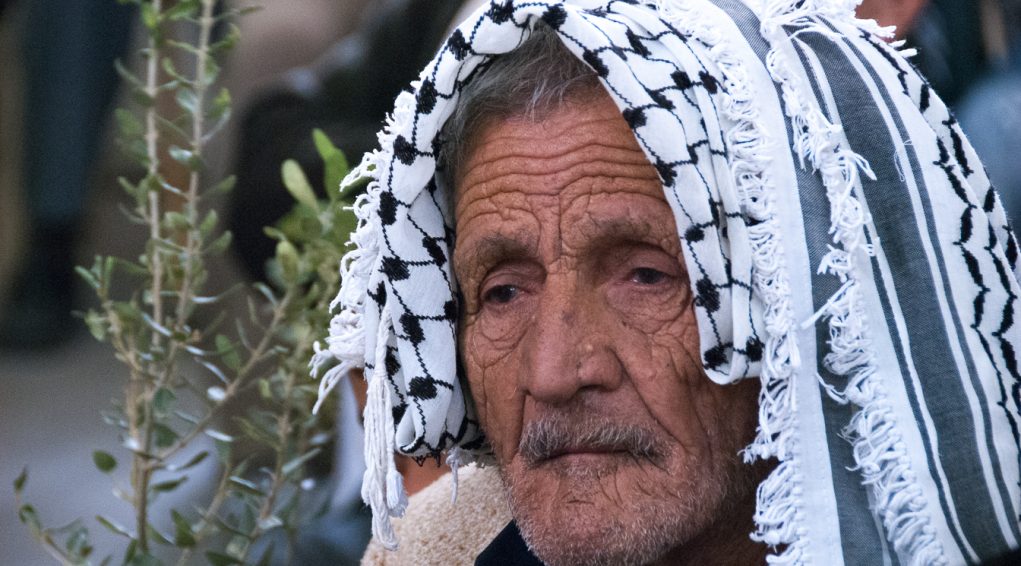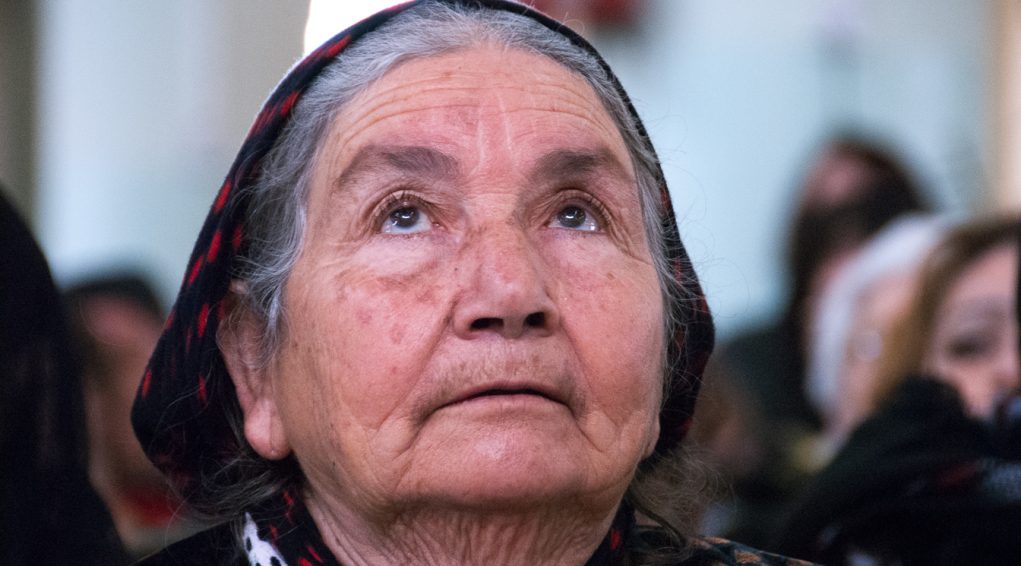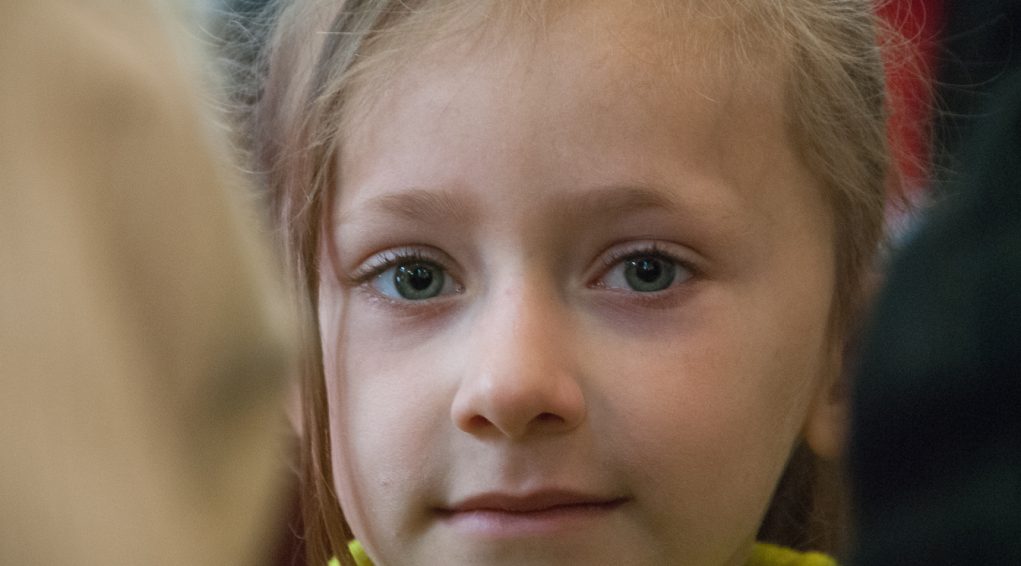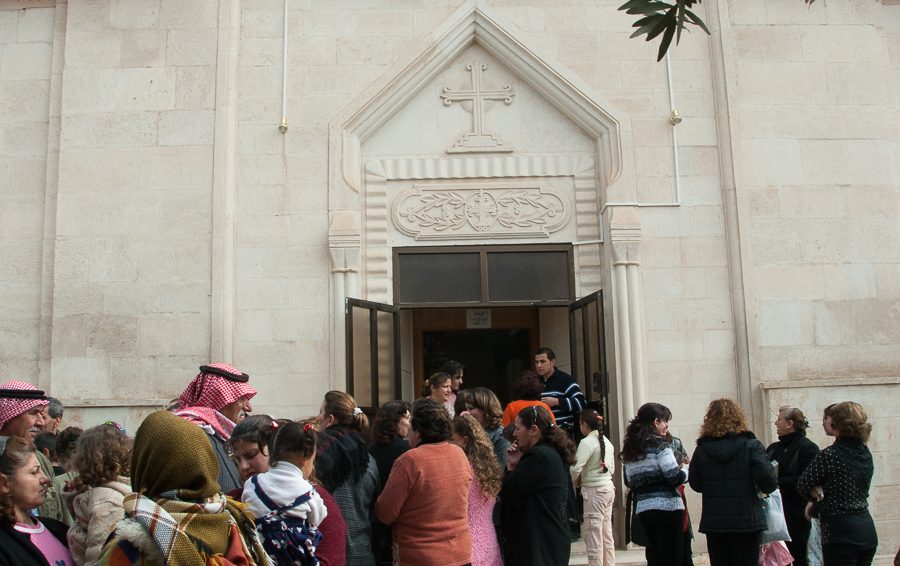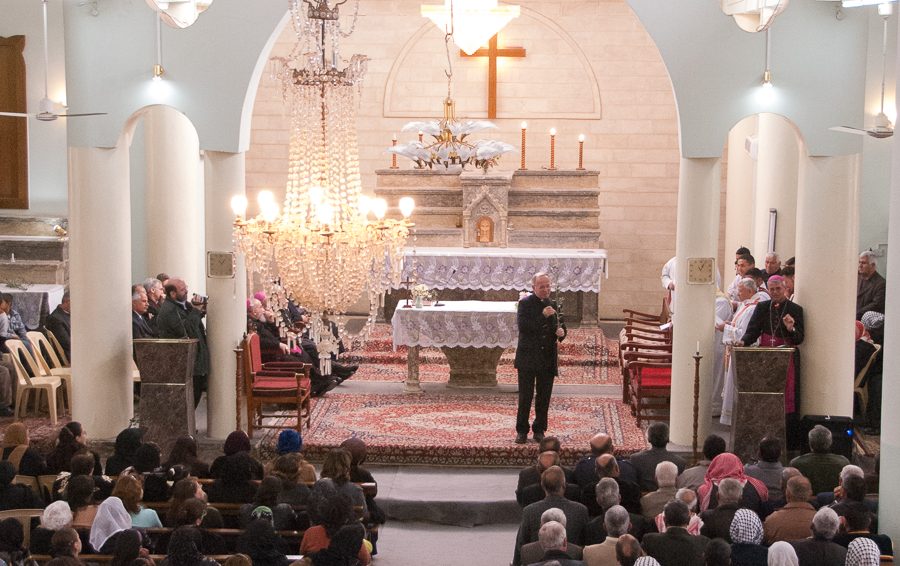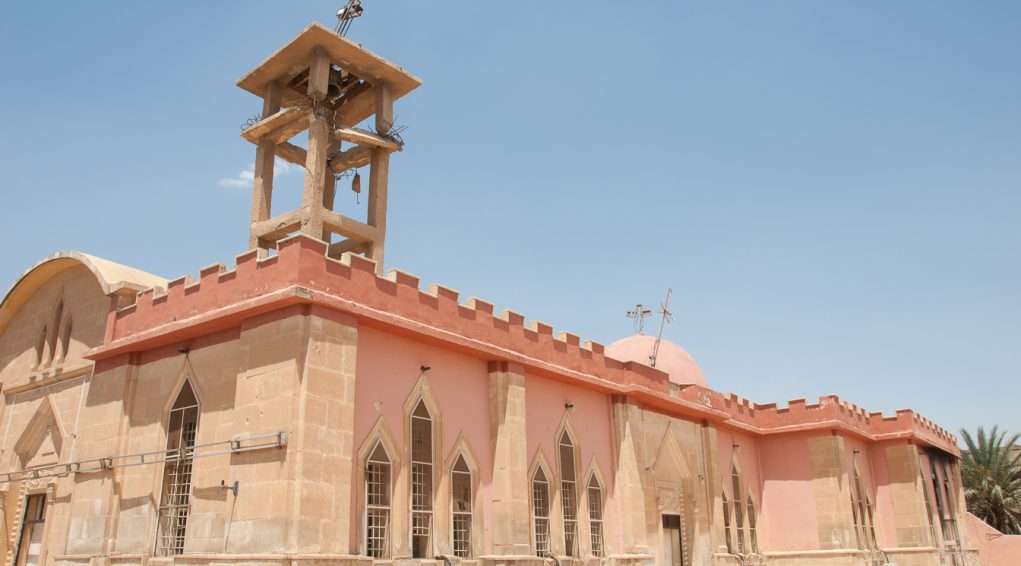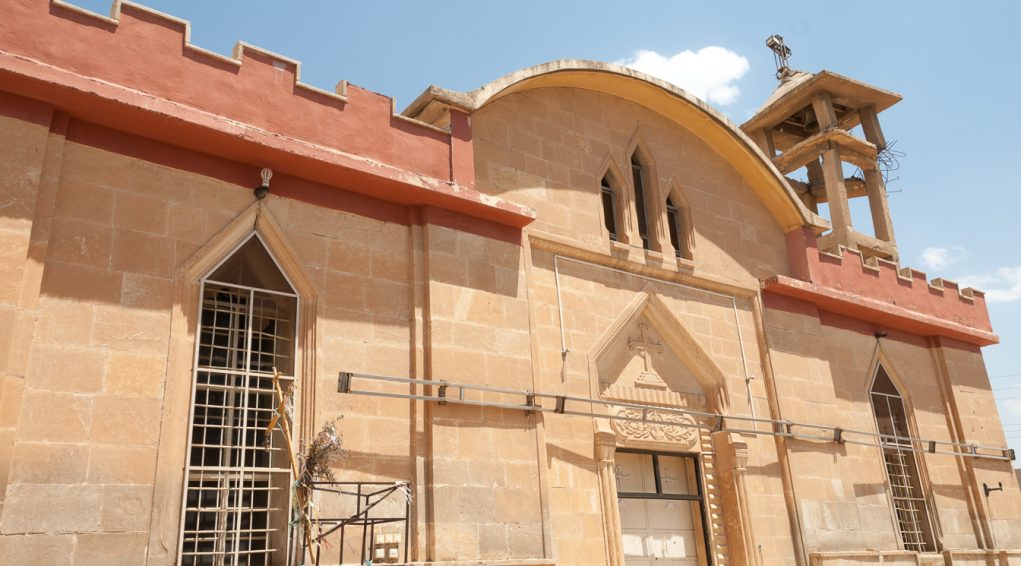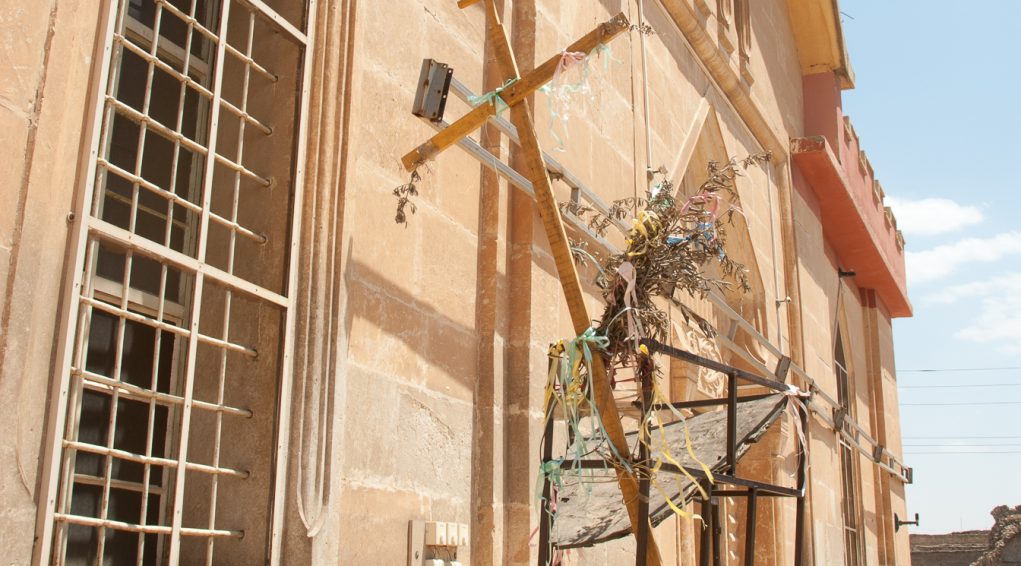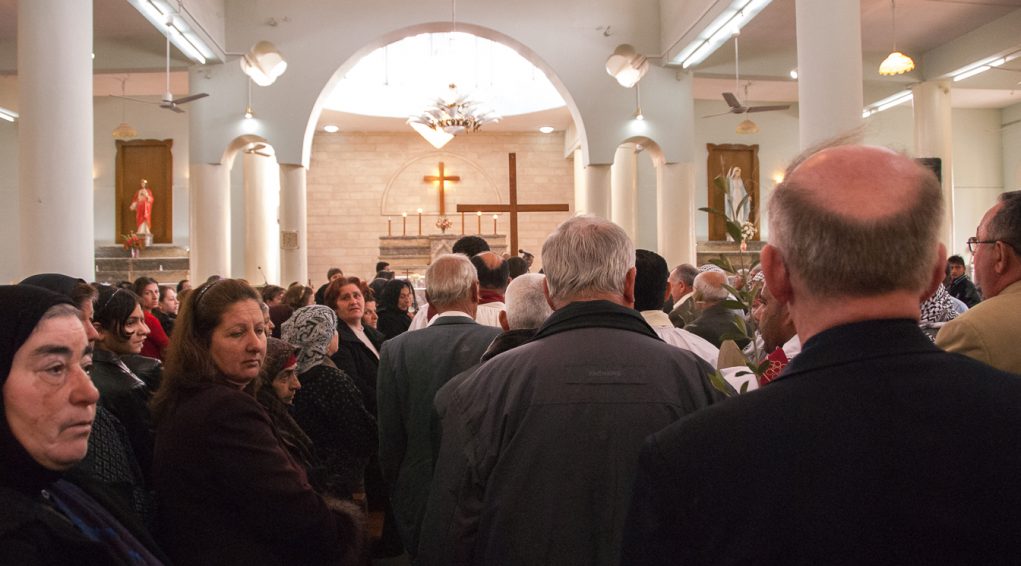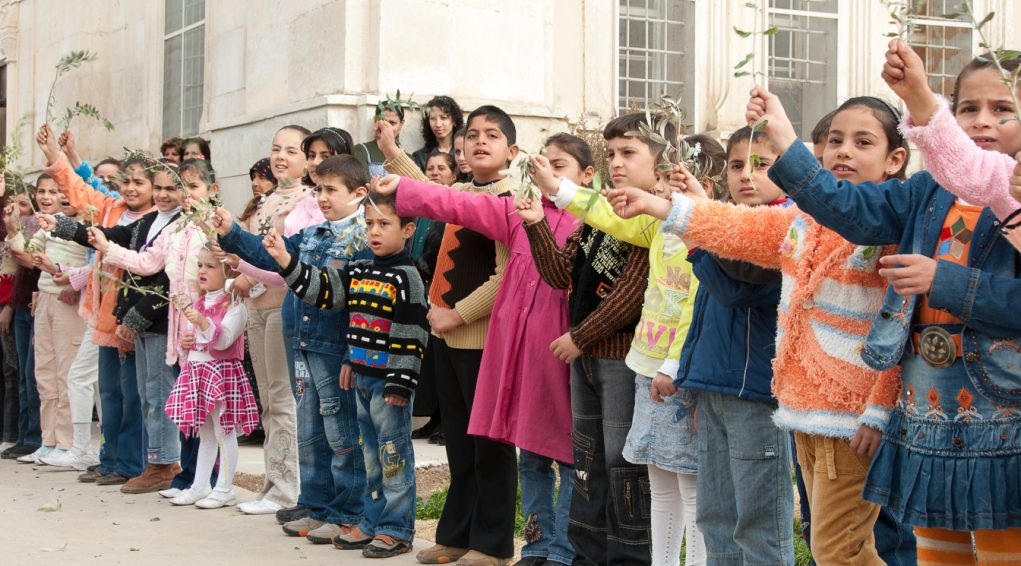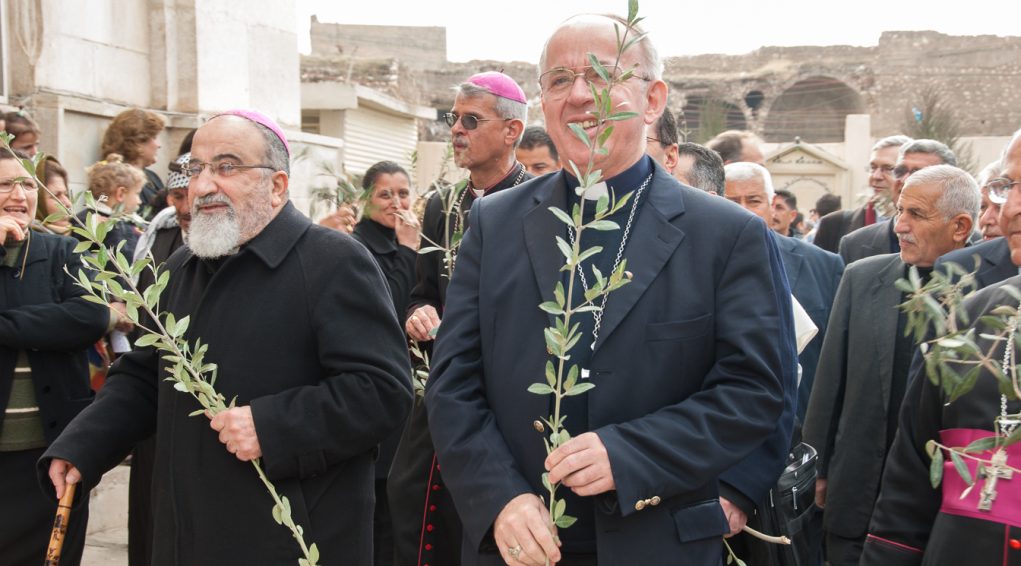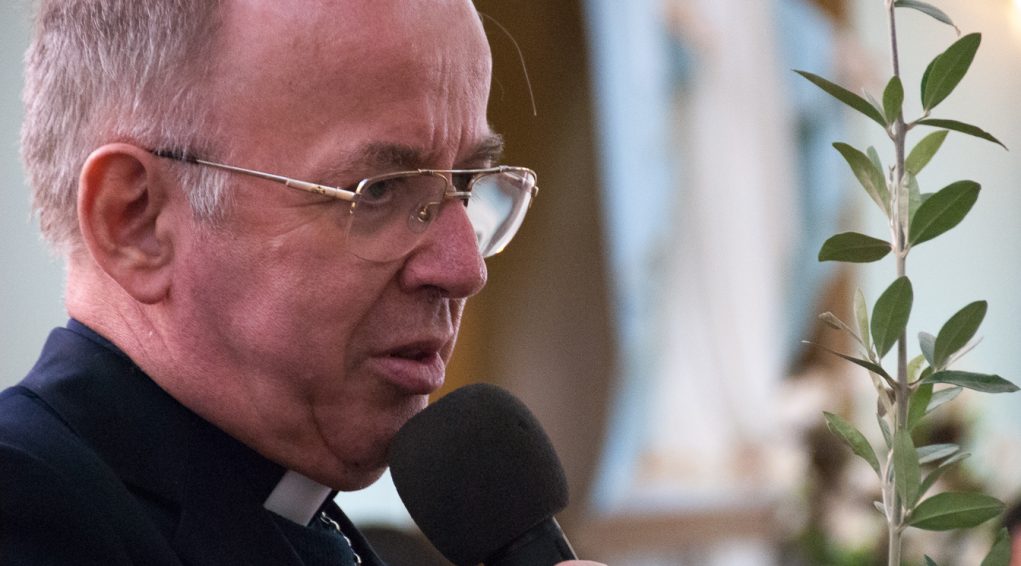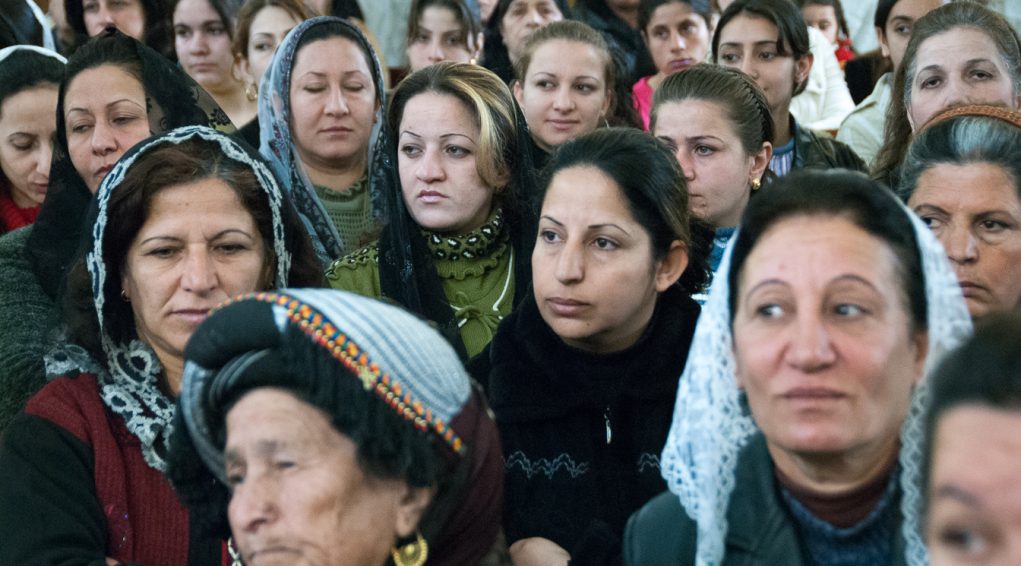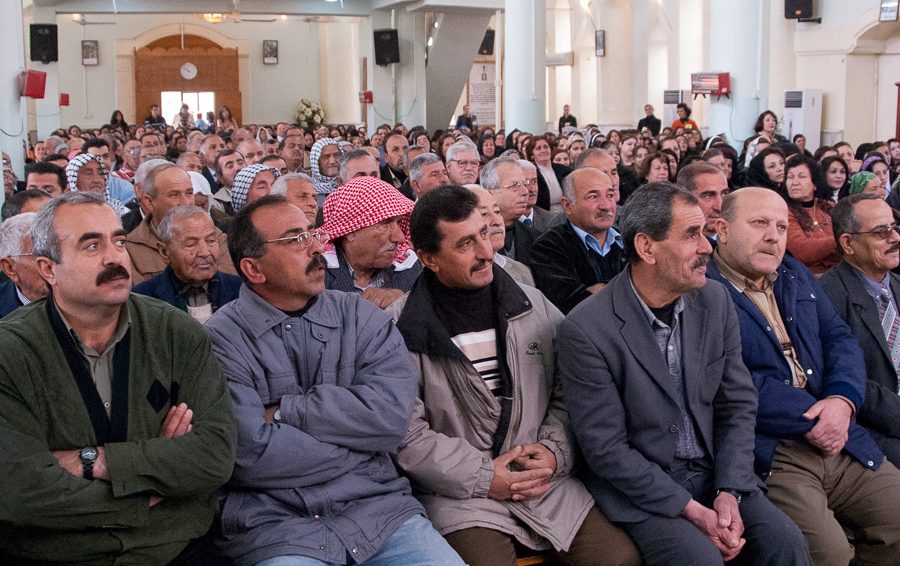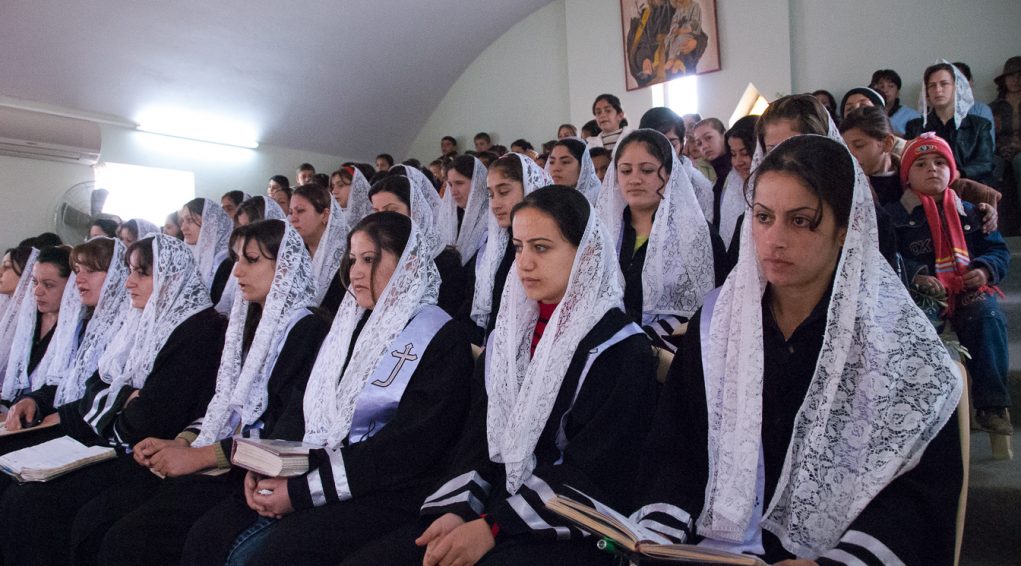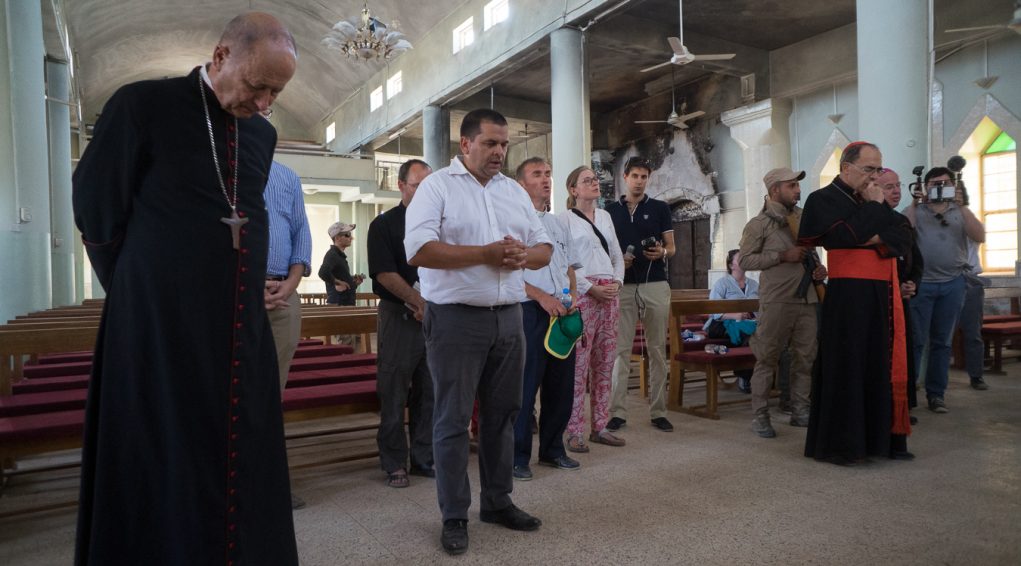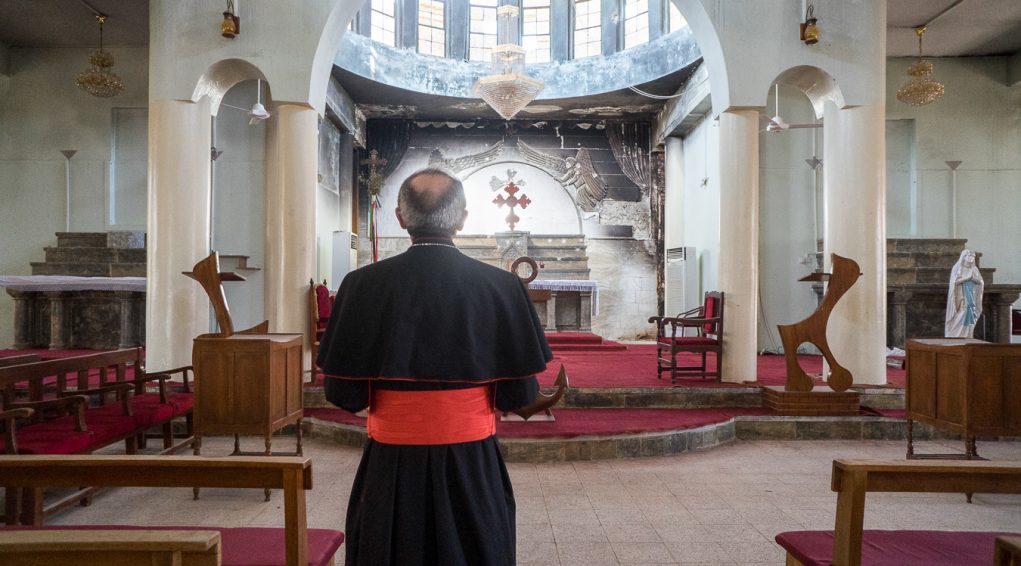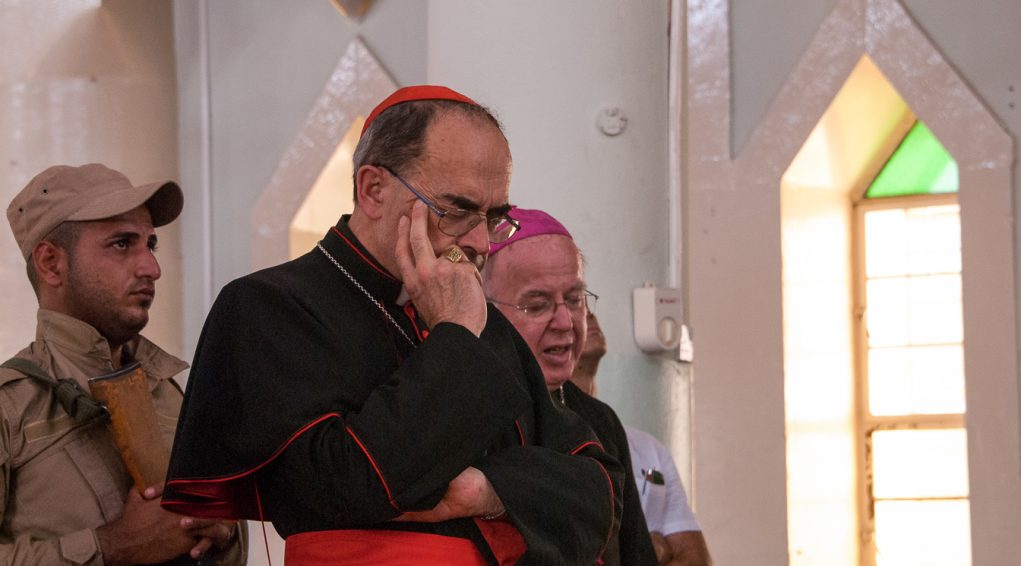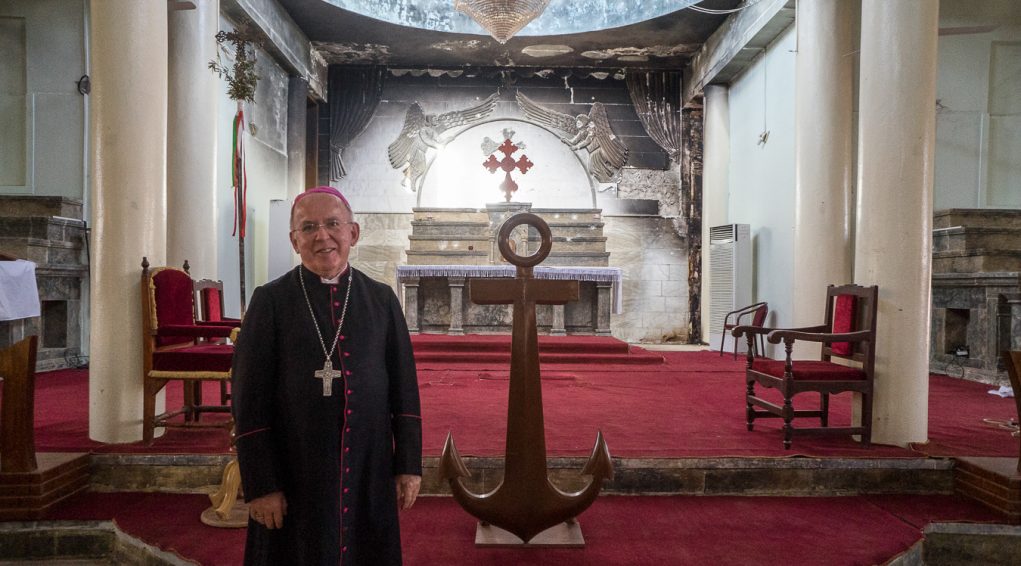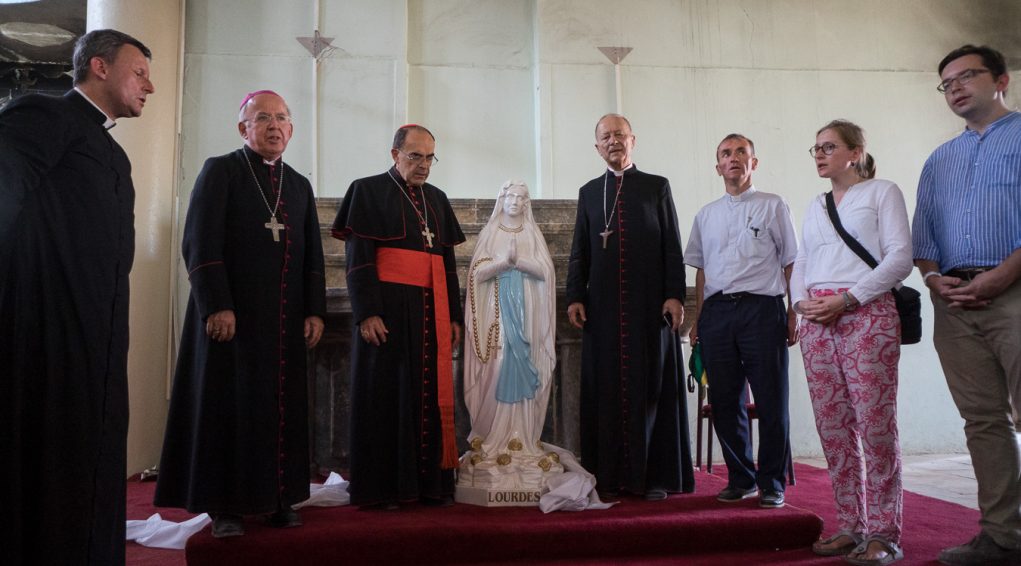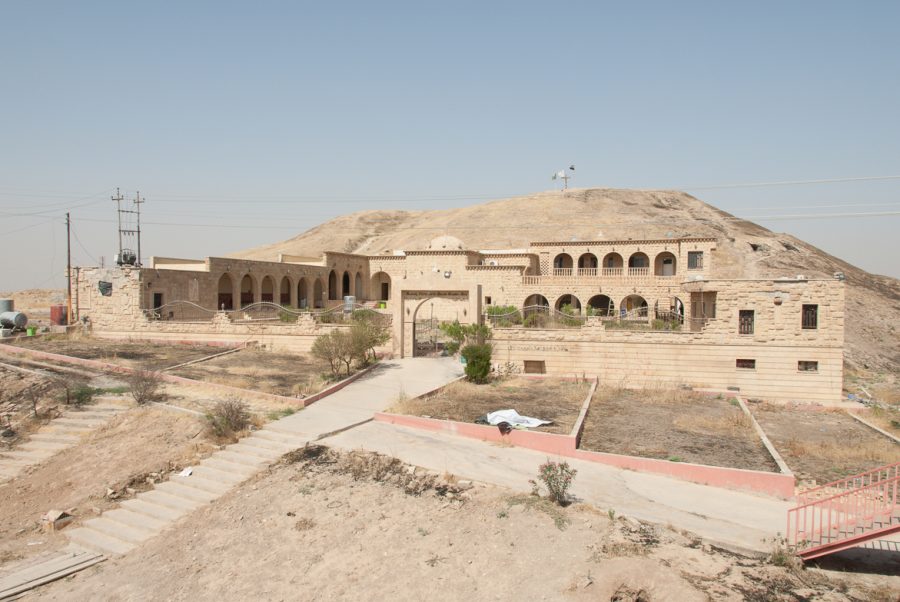The Mar Addai church in Karemles
The Mar Addai church in Karemles is located at 36°18’21.66″N 43°24’53.24″E and 284metres altitude, close to the convent of Saint Barbara.
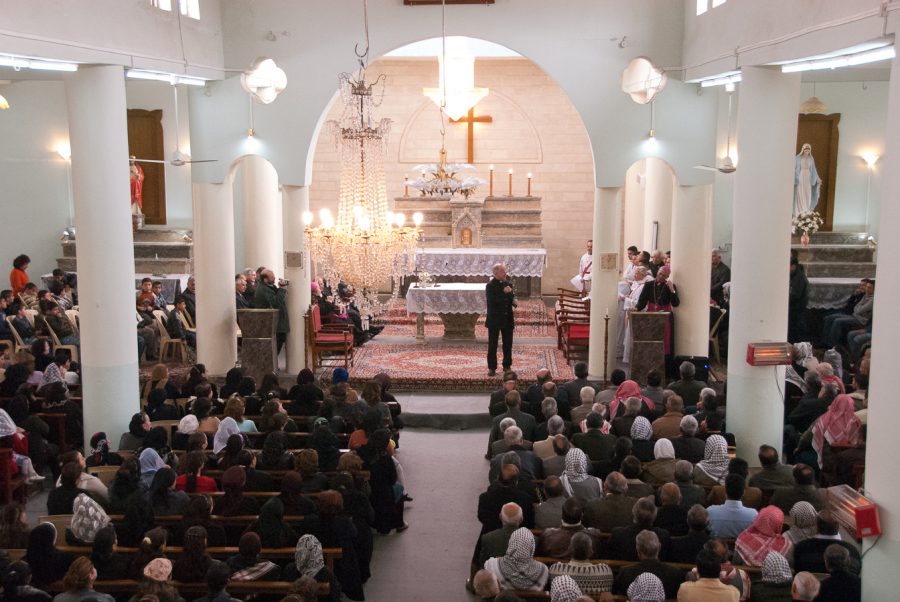
The Mar Addai church is located in the centre of Karemles, 400 metres to the east of the famous convent of Saint Barbara. It is the most modern church in Karemles, built (re-built?) at the beginning of the 1960s. It is more than likely that there was already a church by the name of Mar Addai in Karemles prior to its construction. Relics attributed to Mar Addai were discovered in 1881.
The Mar Addai church in Karemles is named after one of the most prolific evangelisers of Mesopotamia, a disciple of Saint Thomas the apostle, known as the founder of the church in Edessa (modern-day Urfa in Turkey).
The martyrion of the Mar Addai church in Karemles contains the tomb of the Chaldean priest Raghed Ghanni and those of three of his deacons, assassinated by a gang of masked killers on 3 June 2007, in front of the Church of the Holy Spirit in Mosul.
On 14 March 2008, the funeral of the Chaldean archbishop of Mosul-Nineveh, Monsignor Paulos Faraj Raho, took place at the Mar Addai church in Karemles where he was buried. Thousands of people attended his funeral which had a very widespread impact.
Visit from the Pax Christi delegation. Mar Addai Church in Karemles. 13 February 2018 © Pascal Maguesyan
Location
The Mar Addai church in Karemles is located at 36°18’21.66″N 43°24’53.24″E and 284 metres altitude, 400 metres to the east of the convent of Saint Barbara.
Karemles, which in the past was renowned for its immense souk, is found on the road which connects Qaraqosh, 5 km to the south, to Bartella, 10 km to the north.
Toponymy
We can mention several sources to interpret the village’s name. One of them would refer to the Aramaic words Karam lét, which would mean “without vines” according to the 13th century traveller and encyclopaedist Yaqout al Roumi.
The Dominican eastern scholar Jean-Maurice Fiey puts forward a different explanation: “the name Kar-méš is Assyrian, it means the destroyed village or the [deposits] and features in the Balawat tablets.” [1]
_______
[1] In Assyrie Chrétienne, p.458, Jean-Maurice Fiey
Fragments of ancient history
Karemles is often identified as the site of the battle of Gaugamela which opposed the troops of Alexander the Great and Darius III in 331 B.C. For the geographer Vital Cuinet “it is highly likely that it was to the north of Karemles, from this village up to Ghazir that the battle took place (…) The plain is extremely uniform, the Persian cavalry would have been able to cover it easily.”[1] Jean-Maurice Fiey calls into question this geographic identification and suggests that “more detailed study of the texts and in particular the location of the bridge over the Zab used by the warring parties after the battle, situates Alexander’s victory much further north.”[2]
_______
[1] In La Turquie d’Asie -Tome 2nd, Ernest Leroux éditeur, 1891, p. 830[1]
[2] In Assyrie Chrétienne, p.458, Jean-Maurice Fiey
Fragments of Christian history
Karamles seems to have embraced Christianity quite early. As from 562, people from Karamles “assisted in building the Monastery of the monk Bar’Éta, in whose life it is called the Grand Karamles.”[1]
Karamles, like other Christian cities in Mesopotamia, endured all kinds of attacks and destructions. Bar Hebraeus, a 13th-century Maphrian Syriac-Orthodox writer and learned scholar, relates that the Mongols besieged Karamles in 1235. “The inhabitants fled and found refuge in the church, but the Mongols surrounded it. Two noblemen took place at the two doors of the church. One of them spared and set free all those who went out through his door, the other one put to the sword all those, men, women, and children who came through his door.” This event has been much reported in poems and songs that still remain today.[2]
In the first half of the 14th century, the chronicler Ibn ‘Abd ul Haq mentioned that all inhabitants from Karamles were Christian. In 1743 the Persian emperor Nader Shah attacked, plundered and ruined the village, as he had done in the whole area. The plague also affected Karamles more than once. As in 1828, for instance. This was reported in a letter dated August 29th from Pierre-Alexandre Coupperie, Roman Catholic Bishop of Babylon and French Consul, dated 29 August and cited in the review Missions Dominicaines in 1927. He wrote: “famine, civil war and plague wiped out at least half of the Christian population in Mosul and in Kurdistan”,which de facto included Karamles. This was no doubt not the first incident as it affected both Mosul in 1737/38 as well as the nearby Qaraqosh in 1773. [3]
The Christians of Karemles, originally members of the Church of the East (Church of Persia) progressively moved over to the Chaldean Church. Saint Barbara of Karamles is famous for being the first Chaldean church in Iraq.
At his time, Jean-Maurice Fiey drew up a list of 21,00 inhabitants living there, mostly Chaldeans, as well as a Syriac-Orthodox minority of 35 families. He also reported an Apostolic-Armenian presence.
One of the first European chroniclers to mention the Convention of Saint Barbar was the English physician and explorer Edward Ives, originally from Titichfield in Hampshire[4]. On July 2nd1758, he arrived in Karamles, and reported the inhabitants’ stories about Persian looters who destroyed the monastery’s walls, searching for gold[5]. Edward Ives bought there a lectionary, which is now stored at the British Museum. Seven years later, the Dominican priest, Father Domenico Lanza, went to the Monastery in 1765 to celebrate mass[6].
_______
[1]InAssyrie Chrétienne, p.458, Jean-Maurice Fiey
[2]In Assyrie Chrétienne, p.402, Jean-Maurice Fiey
[3]Missions Dominicaines, p.36 s.
[4]« A Voyage from England to India, in the Year MDCCLIV: Also, a Journey from Persia to England, by an unusual route ».
History of the Mar Addai Church in Karemles
There are several churches in Karemles. The Convent of Saint Barbara is found here (èsee notice), the ruins of a 5th century convent in the name of Mar Gorgis, a church named al-Tahira (the pure i.e. the Virgin Mary) and the Mar Addai church.
We have very little information about the Mar Addai church. Considered to be the modern church of Karemeles, it was built (re-built?) at the very beginning of the 1960s, renovated several times over, ransacked by ISIS and rehabilitated in 2017.
It is more than likely that there was already a church by the name of Mar Addai in Karemles prior to the construction of the current church. Relics attributed to Mar Addai were discovered there in 1881. This is what the geographer Vital Cuinet wrote in 1891, “Ten years ago, in an old, large and well-built church in Karamles, we found a small wooden box, covered with iron plates and coated with bitumen, containing precious relics with Chaldean inscriptions which prove its authenticity and attributes them to Mar Addai and Mar Isho-Yab. This box also contains a vial of blood.”[1]
_______
[1]In La Turquie d’Asie -Tome 2nd, Ernest Leroux éditeur, 1891. P.830
About Mar Addai
The Mar Addai church in Karemles bears the name of one of the great evangilisers of Mesopotamia along with his companion Mari. A disciple of Saint Thomas the apostle, Addai is also known the founder of the church of Edessa (modern-day Urfa, in Turkey). Numerous sources designated Addai as Thaddeus of Edessa, one of Christ’s apostles, known for having evangelised Armenia. The Armenian church indicates that he was martyred in Maku, in Persia (north-west Iran). Other, equally numerous sources, believe Addai to be one of the 72 disciples of Christ mentioned in the gospel of Saint Luke (10, 01): “After this the Lord appointed seventy-two others whom he sent ahead of him in pairs to every town and place he intended to visit.”
Mar Addai: a church of contemporary martyrs
The martyrion of the Mar Addai church in Karemles contains the tomb of the Chaldean priest Raghed Ghanni and those of three of his deacons, assassinated by a gang of masked killers on 3 June 2007, in front of the Church of the Holy Spirit in Mosul.
On 14 March 2008, the funeral of the Chaldean archbishop of Mosul-Nineveh, Monsignor Paulos Faraj Raho, took place at the Mar Addai church in Karemles where he was buried. He was kidnapped in the al Nour neighbourhood of Mosul on 29 February 2008. His two bodyguards were killed during the kidnapping. The lifeless body of the martyred archbishop was found on 13 March in the al Intissar neighbourhood of Mosul.
His funeral at Mar Addai in Karemles was attended by thousands of people and huge amounts of correspondence on the subject were received: “The coffin held high by the deacons and priests was preceded by a huge portrait carried by a nun and two bishops (…). Behind followed a huge crowd of mourners, composed of priests, deacons and believers. The ululation of the women merged with the crying and the tears (…) After a moving religious ceremony, the burial took place in the church itself.”[1]
_______
[1]In « Peuples du Monde », n° 422, Avril 2008. Article by Joseph Alichoran, P.38-39
Description of the Mar Addai Church in Karemles
The estate where the church is found is surrounded by a wall and closed off with a metal gate mounted with a cross.
The church can be accessed via several entrances, on the facade and on the sides. The church is built in a neo-traditional style. The building made of stone and reinforced concrete is built like a basilica with a triple nave and four transepts, supported by free-standing smooth columns. The nave is mounted with a semi-circular barrel vault. The side aisles are covered with a flat roof. It has a raised, entirely open bell tower to the south-west of the terrace on the right-hand side aisle, close to the main entrance.
The vast sanctuary, slightly elevated and fully open, is accessed by passing under a large arch adorned with a painting of Mar Addai.
The high altar and its steps are made of marble and practically rests against the wall of the apse. The tabernacle is found at the centre. It evokes the sacred architecture of the Church of the East, whilst a marble altar in the middle of the sanctuary is used by the priests to say mass facing the congregation.
Above the sanctuary, the semi-circular drum dome has windows which let in large amounts of natural light.
On either side of the sanctuary, the side aisles have marble altars with steps. To the south, the altar dedicated to the Virgin Mary is mounted with a large statue of Our Lady of Lourdes. To the north, the altar dedicated to the Sacred Heart of Jesus also contains a statue.
Ransacked, profaned and partly burned down by ISIS, the Mar Addai church was returned to the Chaldean community in November 2016, following the defeat of the Islamist group.
Before the war, the estate on which the Mar Addai church in Karemles is built also contained a number of functional buildings spread around a tree-lined internal courtyard, in particular a small museum and a school run by the nuns of the Chaldean Congregation of the Daughters of Mary.
Fraternity at Mar Addai
On 13 February 2008, the Mar Addai church in Karemles welcomed a delegation from Pax Christi, led by Monsignor Marc Stenger, bishop of Troyes and President of Pax Christi France. Monsignor Paulos Faraj Raho, Chaldean archbishop of Mosul-Nineveh, welcomed them accompanied by a huge, joyful crowd brandishing branches of palm trees as a sign of welcome.
Ten years later, on 24 July 2017, a delegation of bishops from France, led by the cardinal, archbishop of Lyon, Philippe Barbarin, accompanied by Monsignor Marc Stenger, bishop of Troyes and Monsignor Michel Dubost, bishop of Evry came to Karmeles to pray, firstly at the convent of Saint Barbara, then the Mar Addai church. This visit consolidated the fraternal connections between the Christians of France and Iraq and aimed to encourage the efforts of displaced Chaldean families to return to their village of Karemles.
In July 2017, a new statue of Our Lady of Lourdes, gifted by the charity l’Œuvre d’Orient to the Mar Addai church in Karemles was installed at the foot of the altar, to replace the statue destroyed by the Islamist occupants.
News of the church Mar Addaï
Inside, in the thickness of the wall, on the north side of the nave, there is now a memorial which contains objects witnessing the destruction committed by ISIS. Outside, the bell tower was not repaired and testifies also to the contempt committed.
As it’s impossible to reside in Mosul, the new Chaldean Archbishop of Mosul and Akra, Monsignor Najeeb Michaeel, is installed in Karamles. The Mar Addaï church is indeed the cathedral of the archdiocese.
Monument's gallery
Monuments
Nearby
Help us preserve the monuments' memory
Family pictures, videos, records, share your documents to make the site live!
I contribute